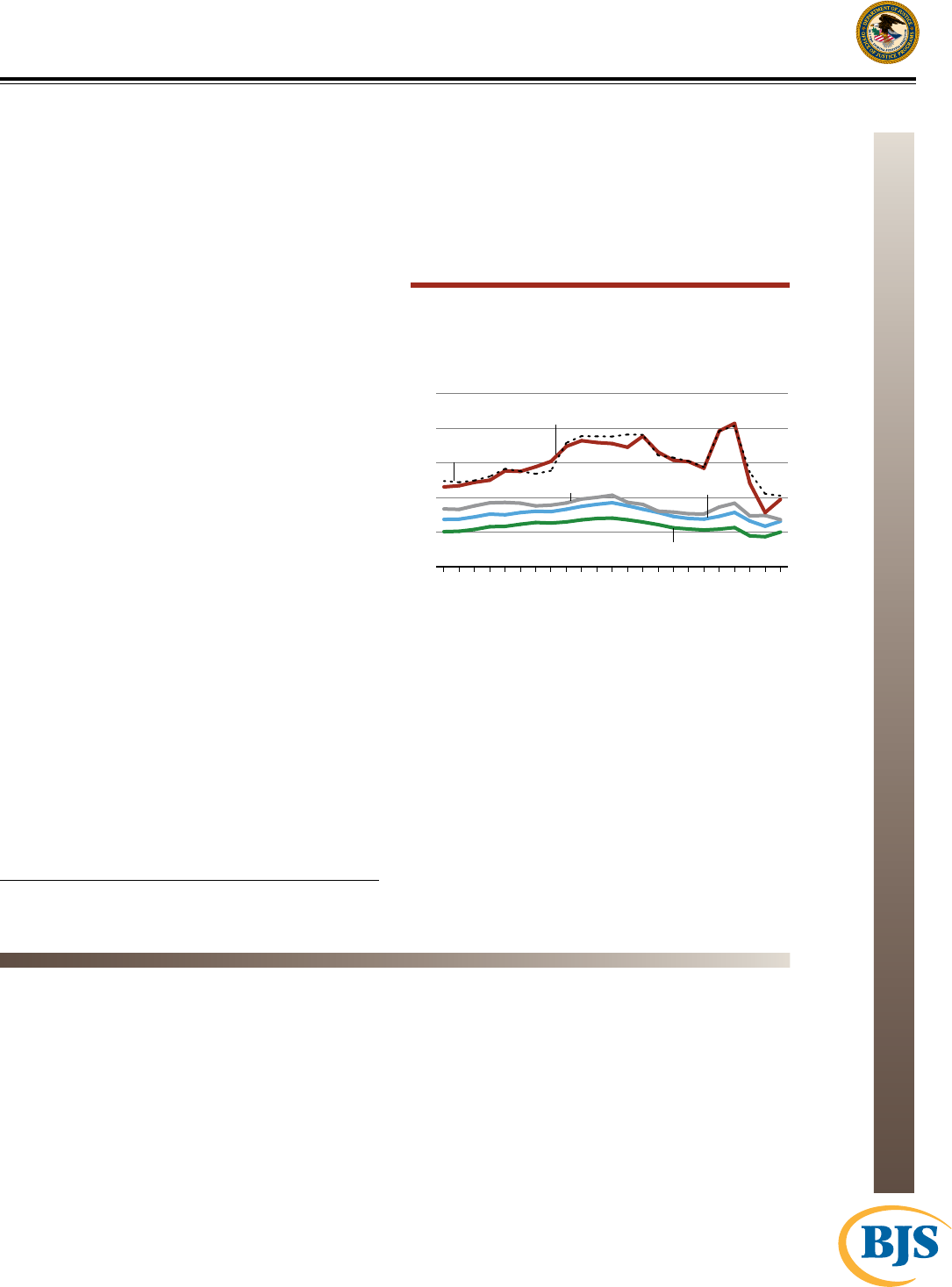
U.S. Department of Justice
Office of Justice Programs
Bureau of Justice Statistics
Bulletin
January 2024, NCJ 307553
Federal Justice Statistics, 2022
Mark Motivans, PhD, BJS Statistician
F
ederal arrests increased 24% from fiscal
year (FY) 2021 to FY 2022 (figure 1).
1
After gradually increasing from 2000 to
2013, federal arrests decreased from 2014 to
2017 before increasing from 2018 to 2019. In
2021, arrests dropped to the lowest level in 20
years (78,068) before rising to 96,857 in 2022. Of
the 350,402 persons under federal correctional
control at fiscal year-end 2022, about 57% were in
secure confinement and 43% were on community
supervision (table 1). This was a 15% decline
from fiscal year-end 2012, when 413,676 persons
were under federal correctional control. This
decline was driven by a drop in the number of
persons in the Federal Bureau of Prisons (BOP)
(from 194,511 in 2012 to 137,603 in 2022).
This report describes cases processed by the
federal criminal justice system. Data are from the
Federal Justice Statistics Program, which collects,
standardizes, and reports on administrative
data received from six federal justice agencies:
the U.S. Marshals Service, Drug Enforcement
Administration, Administrative Office of the U.S.
Courts, Executive Office for U.S. Attorneys, BOP,
and U.S. Sentencing Commission.
1
In this report, annual data are for the fiscal year, which is
from October 1 to September 30.
HIGHLIGHTS
During fiscal year (FY) 2022, federal law
enforcement agencies made 96,857 arrests, a
24% increase from the 78,068 arrests in FY 2021.
In the 26,233 Drug Enforcement Administration
arrests in FY 2022, the most common type of
drug involved was methamphetamine (8,083
arrests), followed by other opioids, including
fentanyl (5,375 arrests).
Persons exiting federal prison in FY 2022 for
nonregulatory public order offenses, including
sex offenses, served more time (66 months) than
persons exiting for violent offenses (56 months)
or drug offenses (53 months).
The median number of days from the receipt of
an investigation to the decision by a U.S. attorney
to prosecute or decline a matter was 60 days in
FY 2022, down from 70 days in FY 2021.
The percent of suspects prosecuted was
highest in immigration (74%), drug (71%), and
weapons(71%) offenses.
The median number of days from case filing in
U.S. district court to case disposition was 314
days in FY 2022, up from 300 days in FY 2021.
FIGURE 1
Suspects and defendants processed in the
federal criminal justice system, FY 2000–2022
Note: Suspects or defendants who had more than one arrest,
charge, or case are counted separately for each occurrence. See
appendix table 1 for counts.
a
Suspects in matters investigated by U.S. attorneys.
b
Suspects arrested by federal law enforcement. Excludes District
of Columbia Superior Court arrests. For 2020 to 2022 arrests,
the custody start date is used instead of the arrest date. See
Methodology.
c
Defendants charged with a felony or a misdemeanor offense in
U.S. district court.
d
Defendants in cases adjudicated with a felony or a
misdemeanor offense in U.S. district court.
Source: Bureau of Justice Statistics, based on data from the
U.S. Marshals Service, Prisoner Tracking, Justice Detainee,
and CAPTURE information systems; Executive Office for U.S.
Attorneys, National Legal Information Office Network System
database; and Administrative Office of the U.S. Courts, Criminal
Master File, fiscal years 2000–2022.
Number (in thousands)
0
50
100
150
200
250
’22’20’18’16’14’12’10’08’06’04’022000
Defendants charged
c
Defendants convicted
d
Defendants sentenced to prison
d
Suspects investigated
a
Suspects arrested
b
Revised June 6, 2024

FEDERAL JUSTICE STATISTICS, 2022 | JANUARY 2024 2
Definitions of major federal offense categories
Violent—Includes murder, negligent or nonnegligent
manslaughter, aggravated or simple assault, sexual
abuse, robbery, kidnapping, and threats against the
U.S.president.
Property—Includes fraudulent and other types of
property offenses.
Fraudulent property—Includes embezzlement,
fraud, forgery, and counterfeiting.
Other property—Includes burglary, larceny,
motor vehicle theft, arson, transportation of stolen
property, and other property offenses, such as
destruction of property and trespassing.
Drug—Includes the manufacture, import, export,
distribution, or dispensing of a controlled or counterfeit
substance, or the possession of a controlled or counterfeit
substance with intent to manufacture or distribute.
Public order—Includes regulatory and other types of
public order offenses.
Regulatory public order—Includes violation of
agriculture, antitrust, labor, food and drug, motor
carrier, and other federal regulations.
Other public order—Includes nonregulatory
violations concerning tax law (tax fraud), bribery,
perjury, national defense, escape, racketeering and
extortion, gambling, liquor, mailing or transporting
obscene materials, traffic, migratory birds, conspiracy,
aiding and abetting, jurisdiction, and other offenses.
Weapons—Includes violations of any of the provisions
of 18 U.S.C. §§ 922–923 concerning the manufacture,
import, possession, receipt, and license of firearms
and ammunition.
Immigration—Includes offenses involving illegal
entrance into the United States, illegal reentry after being
deported, the willful failure to leave when ordered, or
the transportation or harbor of any non-U.S. citizens not
admitted by an immigration officer.
Supervision violations—Includes violations of bail,
violations of pretrial or post-sentencing supervision in the
community (probation), and failures to appear.
TABLE 1
Persons in federal confinement or under federal supervision in the community, fiscal year-end 2012, 2021, and 2022
2012 2021 2022
Number Percent Number Percent Number Percent
Total 413,676 100% 350,453 100% 350,402 100%
In secure confinement 255,375 61.7% 197,808 56.4% 199,928 57.1%
Pretrial detention 60,864 14.7 64,082 18.3 62,325 17.8
Federal Bureau of Prisons (post-sentencing)* 194,511 47.0 133,726 38.1 137,603 39.3
In the community 158,301 38.3% 152,645 43.6% 150,474 42.9%
Pretrial release supervision 26,567 6.4 32,253 9.2 29,615 8.5
Post-sentencing supervision 131,734 31.8 120,392 34.3 120,859 34.5
Supervised release 107,802 26.1 107,338 30.6 107,768 30.8
Probation 22,307 5.4 12,332 3.5 12,466 3.6
Parole 1,625 0.4 722 0.2 625 0.2
Note: Details may not sum to totals due to rounding. Persons in federal confinement or under federal supervision in the community are shown as of
September 30, 2012, 2021, and 2022.
*Counts include federally sentenced persons in the custody of the Federal Bureau of Prisons (BOP) and persons sentenced in U.S. district court. Counts
exclude persons sentenced to the BOP by the District of Columbia Superior Court, military prisoners transferred to BOP facilities to serve their sentence, U.S.
citizen prisoners transferred to the United States from another country to serve their sentence closer to home, and persons convicted of a state offense but
serving time in a federal prison for their security needs. Unsentenced persons in BOP custody are counted separately in pretrial detention counts.
Source: Bureau of Justice Statistics, based on data from the Administrative Office of the U.S. Courts, Probation and Pretrial Services Automated Case Tracking
System; U.S. Marshals Service, CAPTURE information system; and Federal Bureau of Prisons, SENTRY database, fiscal year-end 2012, 2021, and2022.

FEDERAL JUSTICE STATISTICS, 2022 | JANUARY 2024 3
Arrest and booking
Arrests in this section refer to the most serious offenses
that suspects were booked for by deputy U.S. marshals.
In each federal judicial district, deputy U.S. marshals are
responsible for taking suspects charged with a federal
crime into custody (which involves booking, processing,
and detaining the suspects), overseeing court security,
and coordinating prisoner transportation.
In FY 2022, 68% of arrests were for immigration
offenses, supervision violations, and drug offenses
The top three most common arrest offenses in FY
2022 were immigration offenses (24% of all arrests),
supervision violations (23%), and drug offenses (21%)
(table 2). The largest percentage increase in arrests from
2021 to 2022 was for immigration offenses (51%). Arrests
for weapons offenses increased 38% from 5,840 arrests in
FY 2021 to 8,068 arrests in FY 2022. Arrests for property
offenses decreased by 5% from 2021 to 2022.
TABLE 2
Federal arrests, by most serious offense and judicial district, FY 2021 and FY 2022
FY 2021 FY 2022
Percent change,
2021–2022Number Percent Number Percent
Total arrests 78,068 100% 96,857 100% 24.1%
Most serious offense at arrest
Violent 2,834 3.8% 3,409 3.8% 20.3%
Property 7,612 10.3 7,253 8.0 -4.7
Fraud 6,466 8.8 6,227 6.9 -3.7
Other
a
1,146 1.6 1,026 1.1 -10.5
Drug 16,555 22.5 18,563 20.5 12.1
Public order 5,483 7.4 6,229 6.9 13.6
Regulatory 194 0.3 252 0.3 29.9
Other
b
5,289 7.2 5,977 6.6 13.0
Weapons 5,840 7.9 8,068 8.9 38.2
Immigration 14,446 19.6 21,831 24.1 51.1
Material witness 3,603 4.9 4,576 5.0 27.0
Supervision violation 17,256 23.4 20,790 22.9 20.5
Federal judicial district
U.S.-Mexico border district 29,664 38.0% 39,121 40.4% 31.9%
Arizona 5,397 6.9 11,017 11.4 104.1
California Southern 4,671 6.0 5,450 5.6 16.7
New Mexico 2,497 3.2 3,001 3.1 20.2
Texas Southern 10,430 13.4 10,676 11.0 2.4
Texas Western 6,669 8.5 8,977 9.3 34.6
Other judicial districts 48,404 62.0 57,736 59.6 19.3
Note: Details may not sum to totals due to rounding. Each arrest is counted separately, so individuals with more than one arrest are counted more than
once. The most serious offense at arrest is determined by the deputy U.S. marshal at booking. The federal district is the location of the federal court where
booking takes place. The custody start date is used instead of the arrest date (as in years prior to 2020). This is because not all bookings had arrest dates,
due to the U.S. Marshals Service’s transition to a new data system. The custody date is used to ensure all bookings are enumerated, including records that
are missing an arrest date. See Methodology.
a
Includes burglary, larceny, motor vehicle theft, arson, transportation of stolen property, and other property offenses, such as destruction of property
andtrespassing.
b
Includes nonregulatory violations concerning tax law (tax fraud), bribery, perjury, national defense, escape, racketeering and extortion, gambling, liquor,
mailing or transporting obscene materials, traffic, migratory birds, conspiracy, aiding and abetting, jurisdiction, and other offenses.
Source: Bureau of Justice Statistics, based on data from the U.S. Marshals Service, CAPTURE information system, fiscal years 2021 and2022.
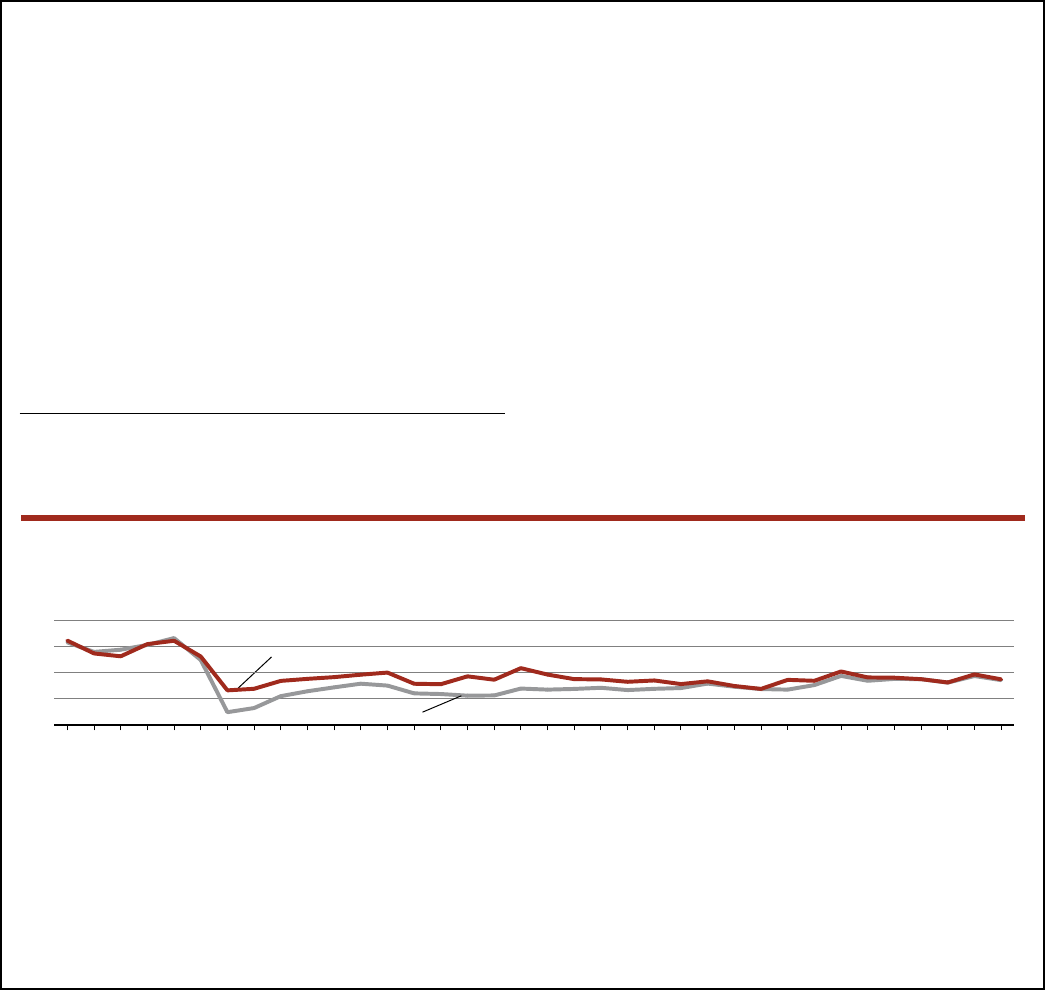
FEDERAL JUSTICE STATISTICS, 2022 | JANUARY 2024 4
Effects of the coronavirus pandemic on the federal criminal justice system
The coronavirus pandemic has had a significant effect
on all stages of the federal criminal justice process, from
arrest to imprisonment. In all federal judicial districts,
U.S. courts modified operations in 2020 and 2021. Fewer
persons were arrested, prosecuted, convicted, and
sentenced to prison. The largest decline in arrests and
cases occurred from March 2020 to April 2020. The second
largest decline in arrests and cases occurred from October
2020 to February 2021. Declines in federal criminal case
processing generally coincided with waves or periods
of sharp increases in confirmed coronavirus cases in the
United States.
2
The number of arrests and cases at fiscal
year-end 2022 remained lower than at the start of the
pandemic in January 2020.
2
Trends in confirmed cases are available at Johns Hopkins
Coronavirus Research Center: https://coronavirus.jhu.edu/region/
united-states.
Federal law enforcement: Investigations and arrests
The number of federal arrests increased 22% from
6,971 in September 2021 to 8,485 in September 2022
(figure 2). The number of suspects investigated by U.S.
attorneys increased 12% during this period, from 7,730 in
September 2021 to 8,638 in September 2022.
The gap between the number of federal arrests and
investigations was widest in April 2020, when there were
4,160 more suspects investigated (6,529) than federal
arrests (2,369). By June 2022, the gap was much closer.
The closing of the gap between investigations and
arrests was mostly due to an increase in arrests during
this period.
FIGURE 2
Suspects investigated and arrested in the federal criminal justice system, October 1, 2019–September 30, 2022
Number (in thousands)
Aug
2021
Jun
2021
Apr
2021
Feb
2021
Dec
2020
Oct
2020
Aug
2022
Jun
2022
Apr
2022
Feb
2022
Dec
2021
Oct
2021
Aug
2020
Jun
2020
Apr
2020
Feb
2020
Dec
2019
Oct
2019
Suspects investigated
a
0
5
10
15
20
Suspects arrested
b
Note: See appendix table 2 for counts.
a
Suspects in matters investigated by U.S. attorneys. Suspects investigated in more than one matter are counted separately.
b
Suspects arrested by federal law enforcement. Each arrest is counted separately, so persons with more than one arrest are counted more than once.
Excludes District of Columbia Superior Court arrests. For 2020 to 2022 arrests, the custody start date is used instead of the arrest date (as in prior
years) because not all bookings in 2020 to 2022 had arrest dates, due to the U.S. Marshals Service’s transition to a new data system. The custody date
is used to ensure all bookings are enumerated, including records that are missing an arrest date. See Methodology.
Source: Bureau of Justice Statistics, based on data from the U.S. Marshals Service, CAPTURE information system; and Executive Office for U.S.
Attorneys, National Legal Information Office Network System database, fiscal years 2020–2022.
Continued on next page
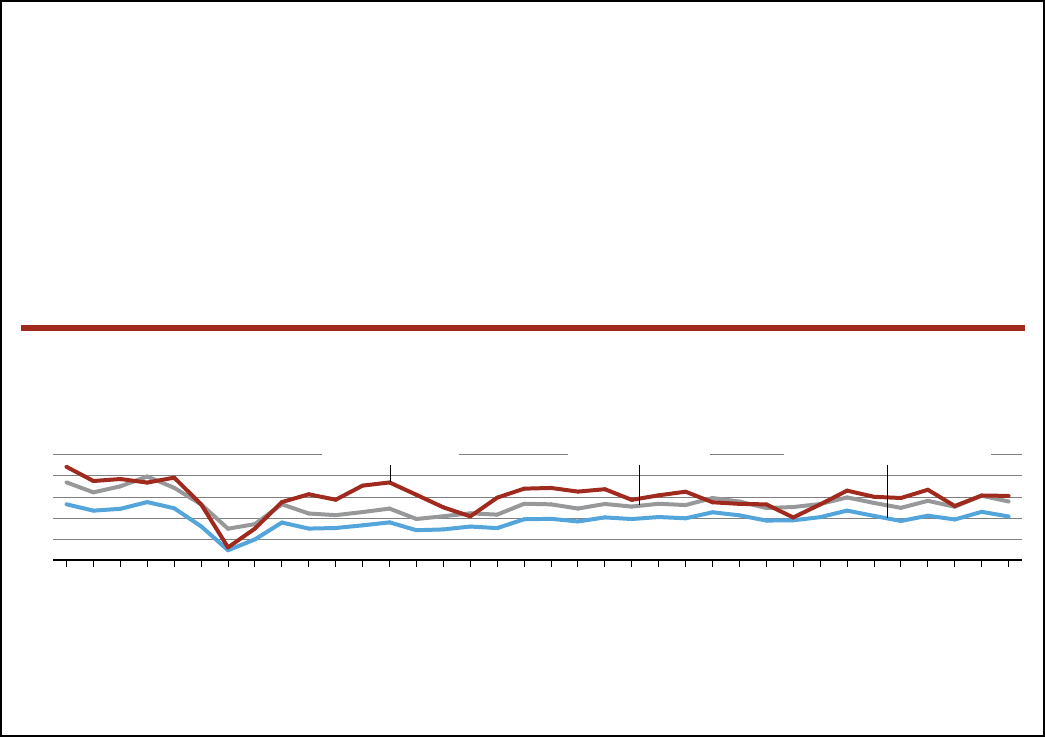
FEDERAL JUSTICE STATISTICS, 2022 | JANUARY 2024 5
Effects of the coronavirus pandemic on the federal criminal justice system
(continued)
Federal court: Charges, convictions, and prison sentences
From September 2021 to September 2022, the number of
persons charged in U.S. district courts dropped 6% (from
6,489 to 6,092) (figure 3). At the same time, the number
convicted in U.S. district courts increased 6% (from 5,225
to 5,563) and the number sentenced to prison increased
4% (from 3,976 to 4,150). The number of persons
charged, convicted, and sentenced to prison remained
lower than before the pandemic. From October 2019 to
September 2022:
2,742 fewer persons were charged
1,803 fewer persons were convicted
1,147 fewer persons were sentenced to prison.
FIGURE 3
Defendants charged, convicted, and sentenced to prison in the federal criminal justice system, October 1,2019–
September 30, 2022
Number (in thousands)
0
2
4
6
8
10
Defendants convicted
b
Defendants charged
a
Aug
2021
Jun
2021
Apr
2021
Feb
2021
Dec
2020
Oct
2020
Aug
2022
Jun
2022
Apr
2022
Feb
2022
Dec
2021
Oct
2021
Aug
2020
Jun
2020
Apr
2020
Feb
2020
Dec
2019
Oct
2019
Defendants sentenced to prison
b
Note: See appendix table 2 for counts.
a
Defendants charged with a felony or a misdemeanor offense in U.S. district court. Defendants charged in more than one case are counted separately.
b
Defendants in cases adjudicated with a felony or a misdemeanor offense in U.S. district court. Defendants in more than one adjudicated case are
counted separately.
Source: Bureau of Justice Statistics, based on data from the Administrative Office of the U.S. Courts, Criminal Master File, fiscal years 2020–2022.
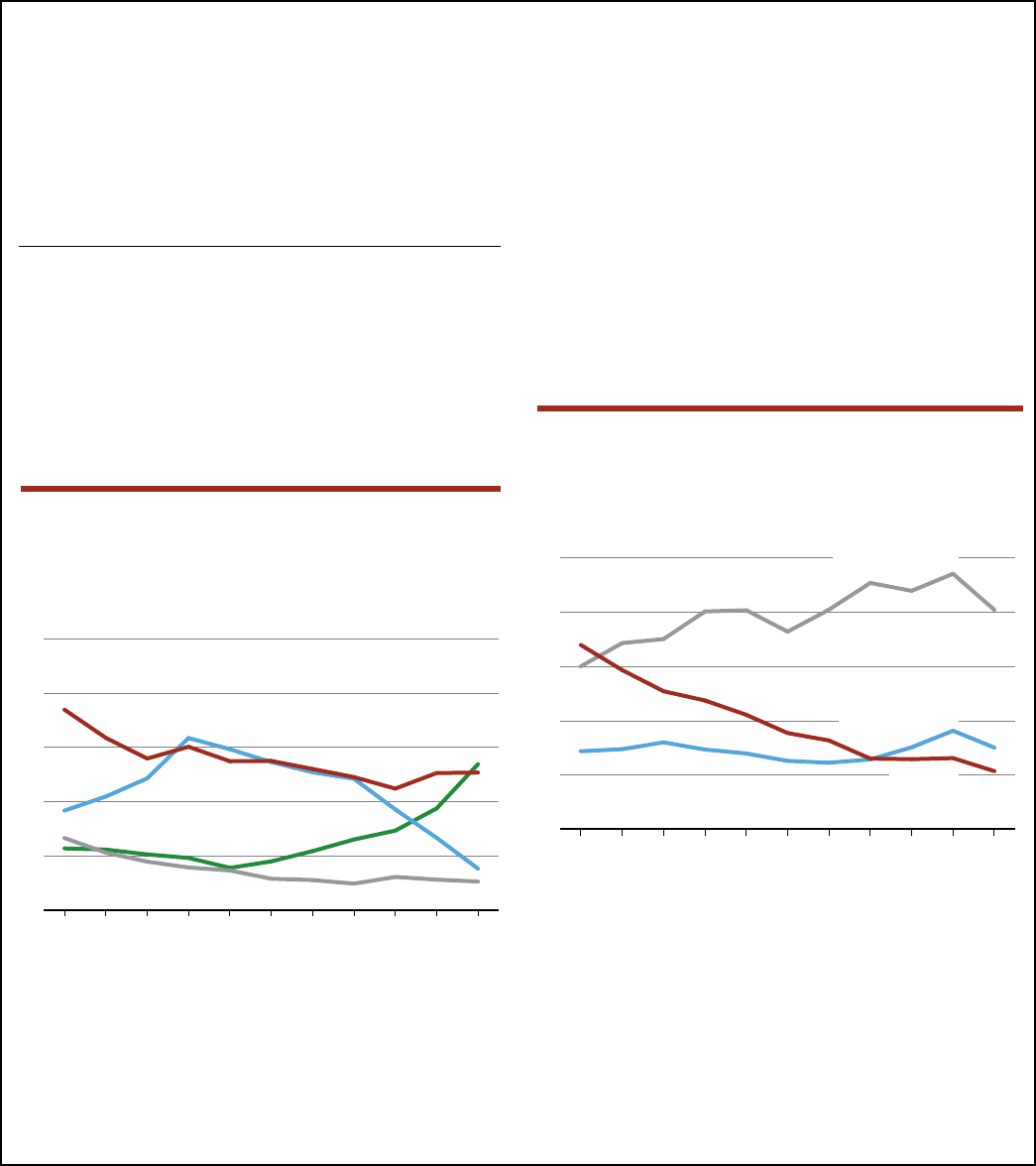
FEDERAL JUSTICE STATISTICS, 2022 | JANUARY 2024 6
Arrests by the Drug Enforcement Administration
The Drug Enforcement Administration (DEA) enforces the
controlled substances laws and regulations of the United
States, including investigating major drug offenses at the
national and international levels. The DEA coordinates
with foreign governments and federal, state, tribal, and
local agencies. It has 239 offices in the United States and
92 offices in 69 countries.
3
3
See https://www.dea.gov/domestic-divisions. “Suspects arrested
by the DEA” describes arrests in which each arrest of an individual
suspect is counted separately. Individual suspects can be arrested
by the DEA more than once in a year. Arrest counts reported by
the DEA overlap with bookings data collected by the U.S. Marshals
Service and reported in table 2. DEA data include all arrests made
by DEA agents and do not describe whether a DEA arrest is a
state or federal case. Therefore, comparisons should not be made
between DEA and U.S. Marshals booking data, which include
bookings for federal cases only.
The DEA reported 26,233 drug arrests in fiscal year (FY)
2022, 7% fewer than in FY 2021 (28,224 arrests). (See
appendix table 3.) Thirty-one percent (8,083) of drug
arrests were for methamphetamine and 20% (5,375)
were for other opioids, including fentanyl, in FY 2022
(figures 4 and 5). From FY 2012 to FY 2022, DEA arrests for
other opioids, including fentanyl, increased the most (44%
per year on average). During that period, arrests declined
an average of 11% for marijuana, 9% for crack cocaine,
8% for heroin, and 4% for powder cocaine each year. DEA
arrests for methamphetamine increased from 6,000 arrests
in FY 2012 to 9,412 arrests in FY 2021 before decreasing to
8,083 arrests in FY 2022.
FIGURE 4
Federal and state arrests by the Drug Enforcement
Administration involving powder cocaine, crack
cocaine, heroin, and other opioids, FY 2012–2022
Note: The unit of count is an arrest by the Drug Enforcement
Administration (DEA). Each arrest for a person is counted separately.
Includes state and federal arrests made by the DEA. See appendix table
3 for counts.
a
Includes heroin, morphine, and opium base.
b
Includes fentanyl, oxycodone, hydrocodone, opioid treatment
pharmaceuticals, hydromorphone, Palladone, and oxymorphone.
Source: Bureau of Justice Statistics, based on data from the Drug
Enforcement Administration, Defendant Statistical System, fiscal years
2012–2022.
Number (in thousands)
Other opioids
b
Heroin
a
Crack cocaine
Powder cocaine
0
2
4
6
8
10
20222021202020192018201720162015201420132012
FIGURE 5
Federal and state arrests by the DrugEnforcement
Administration involving marijuana,methamphetamine,
and other nonopioids, FY 2012–2022
Note: The unit of count is an arrest by the Drug Enforcement
Administration (DEA). Each arrest for a person is counted separately.
Includes state and federal arrests made by the DEA. Includes drug
diversion arrests where drug type is not indicated. See appendix table 3
for counts.
*Includes nonopioid pharmaceutical controlled substances, other
depressants, sedatives, ephedrine, pseudoephedrine, hallucinogens,
synthetic cannabinoids, other steroids, equipment to manufacture
controlled substances, and drug use paraphernalia.
Source: Bureau of Justice Statistics, based on data from the Drug
Enforcement Administration, Defendant Statistical System, fiscal years
2012–2022.
Number (in thousands)
0
2
4
6
8
10
20222021202020192018201720162015201420132012
Methamphetamine
Marijuana
Other nonopioids*
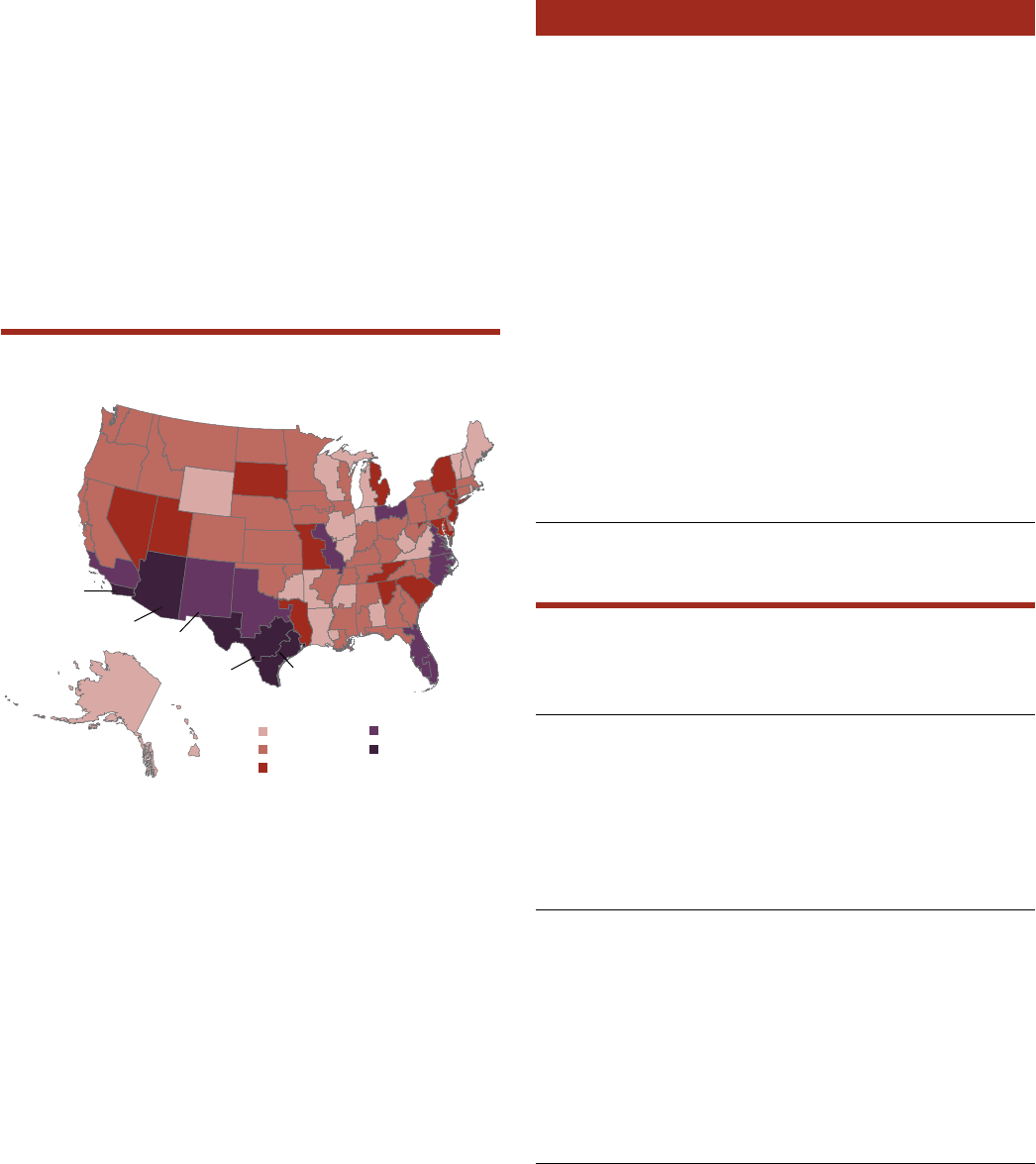
FEDERAL JUSTICE STATISTICS, 2022 | JANUARY 2024 7
About 40% of arrests in FY 2022 were in the five
federal judicial districts along the U.S.-Mexico border
The five federal judicial districts along the U.S.-Mexico
border (California Southern, Arizona, New Mexico,
Texas Western, and Texas Southern) accounted for 40%
of all federal arrests in FY 2022, similar to 38% in 2021
(map 1). (See Federal Justice Statistics, 2021 (NCJ 304314,
BJS, December 2022).) Among the five border districts,
Arizona (11,017) had the most arrests, followed by Texas
Southern (10,676), Texas Western (8,977), California
Southern (5,450), and New Mexico (3,001).
Investigation and prosecution
Ninety-three U.S. attorneys served as the chief federal
prosecutor within their judicial district in FY 2022.
4
Federal law enforcement agencies referred the most
matters to U.S. attorneys in FY 2022, but referrals also
came from state and local law enforcement.
In FY 2022, the Department of Justice referred the
most suspects of any referring authority
Law enforcement agencies within the Department of
Justice (DOJ) referred 45% of suspects in matters sent to
U.S. attorneys in FY 2022, compared to 48% in FY 2021
and 27% in FY 2012. Agencies within the Department
of Homeland Security referred 32% of the 102,329
suspects in matters sent to U.S. attorneys in FY 2022,
down from 57% in FY 2012 (table 3). In FY 2022, about
5% of suspects in matters opened by U.S. attorneys were
referred by federal or state task forces.
4
One U.S. attorney serves two districts: Guam and the Northern
Mariana Islands.
MAP 1
Federal arrests, by judicial district, FY 2022
Note: A total of 96,857 suspects were arrested for a federal offense from
October 1, 2021 to September 30, 2022. Each arrest is counted separately,
so persons with more than one arrest are counted more than once. The
map shows the number of arrests by the federal judicial district, which is
the location of the federal court where booking took place. Not shown:
District of Columbia (298), Guam (49), Northern Mariana Islands (19),
Puerto Rico (1,209), and U.S. Virgin Islands (92). See appendix table 4
forcounts.
Source: Bureau of Justice Statistics, based on data from the U.S. Marshals
Service, CAPTURE information system, fiscal year 2022.
Texas
Southern
(10,676)
Arizona
(11,017)
Texas
Western
(8,977)
New
Mexico
(3,001)
California
Southern
(5,450)
1,200–4,999
5,000 or more
399 or fewer
400–799
800–1,199
TABLE 3
Suspects in matters opened by U.S. attorneys, by
referring authority, FY 2012, FY 2021, and FY 2022
Department/authority FY 2012 FY 2021 FY 2022
Defense 2.3% 1.8% 1.5%
Homeland Security 56.7 28.2 32.2
Interior 2.0 1.0 1.0
Justice 26.9 48.1 45.3
Treasury 1.8 1.4 1.2
Federal/state task force 1.8 4.9 4.9
Other* 8.5 14.7 13.8
Number of suspects 190,596 105,121 102,329
Note: Details may not sum to totals due to rounding. The department or
authority is the entity making the referral for criminal action to the U.S.
attorneys’ offices. Percentages are based on records with nonmissing
referring authority data. The unit of count is a suspect in a matter referred
to U.S. attorneys. Suspects in more than one matter are counted separately.
There were 15 records missing referring authority in 2022, 6missing
referring authority in 2021, and 333 missing referring authority in2012.
*Includes the departments of Agriculture, Commerce, Education, Energy,
Health and Human Services, Labor, State, and Transportation; and state
and local authorities.
Source: Bureau of Justice Statistics, based on data from the Executive
Office for U.S. Attorneys, National Legal Information Office Network System
database, fiscal years 2012, 2021, and 2022.

U.S. attorneys prosecuted 62% of suspects in matters
concluded in FY 2022
U.S. attorneys establish policies and priorities within
their federal judicial districts and determine which cases
they prosecute. In choosing to prosecute, U.S. attorneys
account for factors such as available resources and the
priorities of the DOJ and state and local law enforcement.
To conclude a matter, U.S. attorneys may file charges and
prosecute defendants in U.S. district court, file charges
and dispose of matters before U.S. magistrate judges, or
decline matters, resulting in no further action in U.S.
district court. In FY 2022, the offenses that U.S. attorneys
most commonly chose to prosecute included immigration
offenses (74%), drug offenses (71%) and weapons offenses
(71%), followed by property offenses other than fraud
(56%) (table 4).
U.S. magistrate judges have the authority to adjudicate or
dispose of misdemeanor offenses under 18 U.S.C. §3401.
Magistrate judges’ matters differ from prosecutions in
that they typically require less than 1 hour of an assistant
U.S. attorney’s time and are processed quickly in court.
Twelve percent of matters concluded by U.S. attorneys
in FY 2022 were disposed of by U.S. magistrate judges.
Matters that were most likely to be disposed of by
U.S. magistrate judges included immigration offenses
(25%) and public order offenses other than regulatory
offenses(15%).
U.S. attorneys declined to prosecute 26% of matters
concluded in FY 2022. The cases most likely to be
declined were property fraud (52%) and regulatory
public order (49%) offenses. The median time from
receipt of an investigation to the decision by a U.S.
attorney to prosecute or decline a matter was 60
days in FY 2022, down from 70 days in FY 2021.
(See Federal Justice Statistics, 2021 (NCJ 305127, BJS,
December 2022).)
TABLE 4
Outcome and case-processing time of suspects in matters concluded, by lead charge and judicial district, FY 2022
Number of
suspects
in matters
concluded
Outcome
a
Prosecutor decision/median case-processing time
b
Prosecuted in
U.S. district court
Disposed of by
U.S. magistrate
Declined to
prosecute All cases
Prosecuted in
U.S. district court
Disposed of by
U.S. magistrate
Declined to
prosecute
Total 104,640 62.4% 11.9% 25.7% 60 days 27 days 28 days 609 days
Lead charge
c
Violent 4,707 49.6% 6.8% 43.6% 138 days 39 days 100 days 344 days
Property 16,106 45.7 4.4 49.9 481 216 299 739
Fraud 14,031 44.2 4.0 51.8 532 277 333 755
Other
d
2,075 55.7 7.4 36.9 186 51 214 588
Drug 26,616 71.3 7.0 21.6 82 29 87 664
Public order 16,868 43.1 14.2 42.7 251 67 92 644
Regulatory 2,835 42.2 8.4 49.3 332 42 124 612
Other
e
14,015 43.3 15.3 41.3 241 69 90 653
Weapons 13,830 71.2 4.2 24.6 70 37 87 383
Immigration 26,490 73.5 24.6 1.8 23 23 20 641
Federal judicial district
U.S.-Mexico border 34,746 71.9% 20.4% 7.7% 25 days 24 days 23 days 710 days
Arizona 9,844 51.1 38.9 10.0 27 28 18 675
California Southern 4,283 86.6 8.8 4.6 27 27 29 1,161
New Mexico 3,272 64.5 22.4 13.1 78 68 72 870
Texas Southern 8,290 84.3 10.9 4.8 21 20 22 734
Texas Western 9,057 79.1 13.6 7.3 23 22 26 534
Other judicial districts 69,894 57.6 7.6 34.7 185 54 101 598
a
Details may not sum to totals due to rounding. The unit of count is a suspect in a matter referred to U.S. attorneys. Suspects investigated in more than one
matter are counted separately. There were 23 records missing the suspect’s lead charge.
b
Case-processing time reflects the time from receipt of a matter to the U.S. attorney’s decision to prosecute the matter as a case in U.S. district court, refer
the matter for disposal by a U.S. magistrate judge, or decline the matter, resulting in no further action in U.S. district court. The median is the midpoint of
processing time. A median of 60 days means that half of the suspects received a disposition in less than 60 days of the matter’s referral and half received a
disposition in more than 60 days.
c
The lead charge is the substantive statute that is the primary basis for referral. It is most often, but not always, the charge with the greatest
potentialsentence.
d
Includes burglary, larceny, motor vehicle theft, arson, transportation of stolen property, and other property offenses, such as destruction of property
andtrespassing.
e
Includes nonregulatory violations concerning tax law (tax fraud), bribery, perjury, national defense, escape, racketeering and extortion, gambling, liquor,
mailing or transporting obscene materials, traffic, migratory birds, conspiracy, aiding and abetting, jurisdiction, and other offenses.
Source: Bureau of Justice Statistics, based on data from the Executive Office for U.S. Attorneys, National Legal Information Office Network System database,
fiscal year 2022.
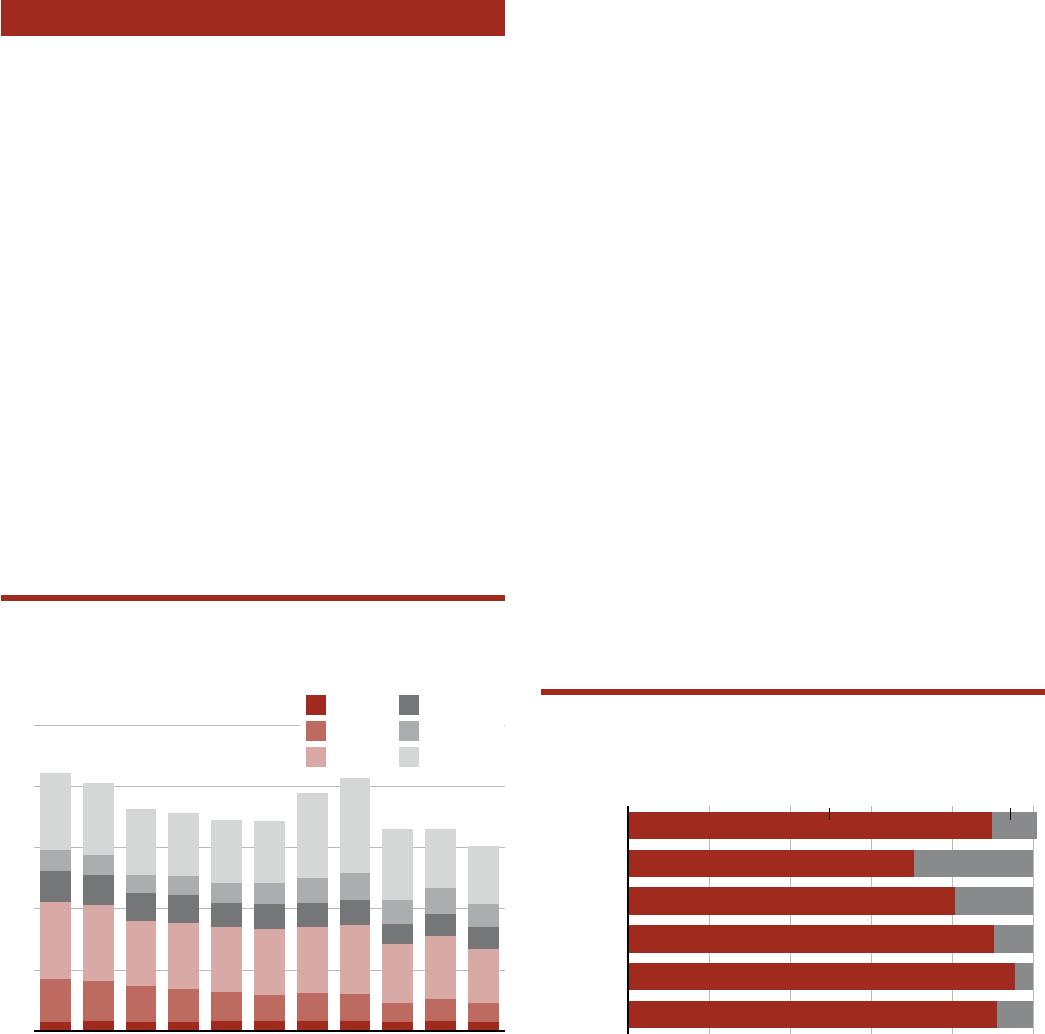
FEDERAL JUSTICE STATISTICS, 2022 | JANUARY 2024 9
Case filing, adjudication, and sentencing
This section describes the workload of U.S. district
courts, including the disposition of criminal proceedings
and the sentencing of convicted defendants. The district
courts serve as the general trial courts of the federal
judicial system and have original jurisdiction over any
case arising under federal statutes, the U.S. Constitution,
or treaties. Each U.S. district court has at least one U.S.
district judge, who is appointed by the U.S. president and
confirmed by the U.S. Senate.
15% fewer defendants were charged with drug
offenses in FY 2022 than in FY 2021
From FY 2021 to FY 2022, the number of defendants
charged with a federal offense decreased by 8%, from
65,880 to 60,490 (figure 6). During that period, the
number of persons charged with drug offenses decreased
15% and the number of persons charged with violent
offenses decreased 13%. The number of persons charged
with public order offenses decreased 1%.
Most defendants charged in U.S. district court in FY
2022 were male
A total of 49,830 males and 7,722 females were charged
in U.S. district court in FY 2022, with males accounting
for 86% of all defendants and females accounting for 14%
(table 5). Females made up 30% of defendants charged
with a property offense and 19% of defendants charged
with a drug offense (figure 7).
Fifty-three percent of defendants charged in U.S. district
court in FY 2022 were Hispanic. Sixty-four percent of
defendants were ages 25 to 44, and 15% were age 50 or
older. The youngest defendants (age 19 or younger) and
oldest defendants (age 65 or older) together made up
3% of persons charged in FY 2022. Forty-four percent
of females charged in U.S. district court in 2022 were
Hispanic, 32% were white, and 19% were black. Of the
males charged, 54% were Hispanic, 24% were black,
and 19% were white. Eighty-four percent of charged
females were U.S. citizens. Males who were charged were
also more likely to be U.S. citizens (62%) than non-U.S.
citizens (38%). Other than the United States, the most
common countries or regions of citizenship among male
defendants were Mexico (26%), Central America (7%),
and the Caribbean Islands (2%).
FIGURE 6
Defendants in criminal cases filed in U.S. district court, by
most serious offense, FY 2012–2022
Note: The unit of count is a defendant in a case filed in U.S. district court.
Defendants charged in more than one case are counted separately.
Includes defendants charged in U.S. district court with a felony or a
misdemeanor offense as the most serious charge. See appendix table 5
forcounts.
Source: Bureau of Justice Statistics, based on data from the Administrative
Office of the U.S. Courts, Criminal Master File, fiscal years 2012–2022.
Number (in thousands)
0
20
40
60
80
100
20222021202020192018201720162015201420132012
Immigration
Weapons
Public order
Drug
Property
Violent
FIGURE 7
Defendants charged in U.S. district court, by sex and
most serious offense, FY 2022
Note: The unit of count is a defendant in a case filed in U.S. district court.
Defendants charged in more than one case are counted separately.
Includes defendants charged in U.S. district court with a felony or a
misdemeanor offense as the most serious charge. Percentages are based
on nonmissing data. There were 176 records missing the defendant’s
sex and 163 missing the defendant’s offense type. See appendix table 6
forpercentages.
Source: Bureau of Justice Statistics, based on data from the Administrative
Office of the U.S. Courts, Probation and Pretrial Services Automated Case
Tracking System, fiscal year 2022.
Most serious offense
0 20 40 60 80 100
Immigration
Weapons
Public order
Drug
Property
Violent
FemaleMale
Percent

FEDERAL JUSTICE STATISTICS, 2022 | JANUARY 2024 10
TABLE 5
Defendants charged in U.S. district court, by sex and demographic characteristics, FY 2022
Demographic characteristic
All defendants Male Female
Number Percent Number Percent Number Percent
Total 57,728 100% 49,830 100% 7,722 100%
Race/ethnicity
White
a
11,420 20.8% 9,097 19.1% 2,319 31.8%
Black
a
12,680 23.0 11,312 23.7 1,364 18.7
Hispanic 28,937 52.6 25,701 53.9 3,228 44.2
Asian/Native Hawaiian/
Other Pacific Islander
a
780 1.4 617 1.3 163 2.2
American Indian/Alaska Native
a
1,218 2.2 988 2.1 229 3.1
Age
19 or younger 675 1.2% 586 1.2% 89 1.2%
20–24 6,071 10.6 5,142 10.3 924 12.0
25–29 8,856 15.4 7,612 15.3 1,240 16.1
30–34 10,143 17.6 8,820 17.7 1,319 17.1
35–39 9,540 16.6 8,275 16.6 1,259 16.3
40–44 8,238 14.3 7,223 14.5 1,013 13.1
45–49 5,665 9.8 4,996 10.0 665 8.6
50–54 3,647 6.3 3,168 6.4 477 6.2
55–59 2,261 3.9 1,926 3.9 333 4.3
60–64 1,356 2.4 1,148 2.3 206 2.7
65 or older 1,119 1.9 923 1.9 195 2.5
Median age 36 yrs. ~ 36 yrs. ~ 36 yrs. ~
Citizenship
U.S. citizen 37,407 65.2% 30,937 62.3% 6,451 84.1%
Non-U.S. citizen 19,937 34.8 18,706 37.7 1,222 15.9
Country/region of citizenship
North America 56,081 97.8% 48,515 97.7% 7,539 98.3%
United States 37,407 65.2 30,937 62.3 6,451 84.1
Mexico 13,864 24.2 13,018 26.2 839 10.9
Canada 57 0.1 52 0.1 5 0.1
Caribbean Islands
b
1,060 1.8 1,005 2.0 55 0.7
Central America
b
3,693 6.4 3,503 7.1 189 2.5
South America
b
645 1.1 578 1.2 67 0.9
Asia and Oceania
b
301 0.5 260 0.5 40 0.5
Europe
b
171 0.3 154 0.3 17 0.2
Africa
b
146 0.3 136 0.3 10 0.1
Note: Details may not sum to totals due to rounding. The unit of count is a defendant in a case filed in U.S. district court. Defendants charged in more than
one case are counted separately. Includes defendants charged in U.S. district court with a felony or a misdemeanor offense as the most serious charge.
Percentages are based on nonmissing cases. There were 176 records missing the defendant’s sex, 2,693 missing the defendant’s race or ethnicity, 157
missing the defendant’s age, and 384 missing the defendant’s citizenship status.
~Not applicable.
a
Excludes persons of Hispanic origin (e.g., “white” refers to non-Hispanic white persons and “black” refers to non-Hispanic black persons). Defendants self-
reported race and ethnicity during the pretrial interview. Information was collected for one race and one ethnicity category.
b
Countries aggregated by region.
Source: Bureau of Justice Statistics, based on data from the Administrative Office of the U.S. Courts, Probation and Pretrial Services Automated Case
Tracking System, fiscal year 2022.

FEDERAL JUSTICE STATISTICS, 2022 | JANUARY 2024 11
9 in 10 defendants adjudicated in U.S. district court
in FY 2022 were convicted
Of the 71,542 defendants adjudicated in FY 2022, about
92% were convicted (table 6). Nearly all defendants
charged with immigration (98%), weapons (94%), or
drug (92%) offenses were convicted. About 90% of
adjudicated defendants pled guilty. Two percent of
defendants were convicted through a bench or jury trial.
Defendants adjudicated in U.S.-Mexico border districts
had a higher conviction rate (96%) than defendants
in nonborder districts (89%). Among felony offenses,
rates of nonconviction ranged from 2% for immigration
offenses to 12% for regulatory offenses. Cases that
were dismissed or otherwise concluded by the judge or
prosecutor accounted for most nonconvictions (8%).
Acquittals (413 days), dismissals (314 days), and guilty
pleas (302 days) took less time to process from case filing
to disposition than trials that ended in convictions (776
days). The median days from case filing in U.S. district
court to case disposition increased by 5% from 300 days
in FY 2021. (See Federal Justice Statistics, 2021 (NCJ
305127, BJS, December 2022).) During this period, the
median case processing time decreased the most for
cases disposed by a dismissal (down 18%).
TABLE 6
Disposition and case-processing time of defendants in cases adjudicated in U.S. district court, by most serious offense
and judicial district, FY 2022
Total cases
adjudicated
Convicted Not convicted
Total Guilty plea Bench/jury trial Total Bench/jury trial Dismissed
All offenses 71,542 91.5% 89.6% 1.9% 8.5% 0.5% 8.0%
Most serious offense at adjudication
Felony 67,055 93.2% 91.2% 2.0% 6.8% 0.5% 6.4%
Violent 2,970 89.2 83.1 6.0 10.8 1.4 9.4
Property 7,426 90.1 87.3 2.7 9.9 0.7 9.3
Fraud 6,439 89.7 86.9 2.8 10.3 0.7 9.6
Other
a
987 92.4 90.1 2.3 7.6 0.4 7.2
Drug 22,396 91.6 89.8 1.9 8.4 0.3 8.0
Public order 6,569 91.0 87.0 4.1 9.0 0.9 8.1
Regulatory 722 87.7 82.1 5.5 12.3 3.6 8.7
Other
b
5,847 91.4 87.6 3.9 8.6 0.6 8.0
Weapons 10,109 93.9 91.6 2.2 6.1 0.7 5.5
Immigration 17,585 97.6 97.2 0.3 2.4 0.1 2.3
Misdemeanor 4,487 66.6 65.8 0.8 33.4 0.4 33.1
Federal judicial district
U.S.-Mexico border 24,596 95.8% 95.1% 0.7% 4.2% 0.2% 4.0%
Arizona 4,687 96.5 95.8 0.7 3.5 0.2 3.3
California Southern 4,013 87.7 87.2 0.5 12.3 0.4 11.9
New Mexico 2,208 97.1 96.8 0.3 2.9 0.1 2.9
Texas Southern 7,498 97.4 97.0 0.4 2.6 0.2 2.4
Texas Western 6,190 98.2 96.9 1.4 1.8 0.2 1.5
Other judicial districts 46,946 89.2 86.7 2.6 10.8 0.6 10.2
Median time from filing to disposition
c
314 days 309 days 302 days 776 days 415 days 413 days 314 days
Note: Details may not sum to totals due to rounding. Includes information on felony defendants; Class A misdemeanor defendants, whether cases were
handled by U.S. district judges or U.S. magistrate judges; and other misdemeanor defendants, provided their cases were handled by U.S. district judges.
Court personnel determine the most serious offense at adjudication as the offense with the greatest statutory maximum sentence. The unit of count is a
defendant in a case adjudicated in U.S. district court. Defendants in more than one case are counted separately. The median is the midpoint between the
slowest and fastest processing times. A median of 314 days means that half of the defendants received a disposition in less than 314 days and half received
a disposition in more than 314 days.
a
Includes burglary, larceny, motor vehicle theft, arson, transportation of stolen property, and other property offenses, such as destruction of property and
trespassing.
b
Includes nonregulatory violations concerning tax law (tax fraud), bribery, perjury, national defense, escape, racketeering and extortion, gambling, liquor,
mailing or transporting obscene materials, traffic, migratory birds, conspiracy, aiding and abetting, jurisdiction, and other offenses.
c
Includes the interval from the time a case was filed in U.S. district court to sentencing for defendants who were convicted and the interval from case filing
to disposition for defendants who were not convicted or whose cases were dismissed.
Source: Bureau of Justice Statistics, based on data from the Administrative Office of the U.S. Courts, Criminal Master File, fiscal year 2022.

FEDERAL JUSTICE STATISTICS, 2022 | JANUARY 2024 12
3 in 4 convicted defendants were sentenced to
prison in FY 2022
Of the 65,470 defendants convicted in U.S. district
court in FY 2022, more than three-quarters (77%) were
sentenced to prison (table 7). The remainder received
probation only (8%), a fine only (2%), or a suspended
sentence (14%). Persons most likely to receive prison
terms were those convicted of violent (93%), drug (89%),
or weapons (89%) felonies. Seventeen percent of persons
convicted of a misdemeanor received a prison sentence
in FY 2022.
Defendants sentenced to prison in FY 2022 received
a median term of 41 months
In FY 2022, the median prison sentence for a felony was
41 months, up from a median of 37 months in FY 2021.
(See table 7 in this report and Federal Justice Statistics,
2021 (NCJ 305127, BJS, December 2022).) Convicted
defendants received a median sentence of 110 months
in prison for a violent offense, 70 months for a drug
offense, and 60 months for a nonregulatory public
order offense. The median prison term for immigration
defendants convicted of a felony was 13 months.
Defendants convicted and sentenced to prison in the five
U.S.-Mexico border districts received a median sentence
of 18 months, compared to a median of 60 months in
other districts. This was due to the higher percentage of
immigration cases in the border districts.
TABLE 7
Type and length of sentence imposed for convicted defendants, by most serious offense and judicial district, FY 2022
Number convicted
Type of sentence
Median prison termPrison
a
Probation only Fine only Suspended
All offenses 65,470 76.5% 7.9% 2.1% 13.6% 41 mos.
Most serious offense at conviction
Felony 62,482 79.3% 6.5% 0.5% 13.7% 41 mos.
Violent 2,648 92.8 2.6 0.3 4.3 110
Property 6,688 63.0 20.7 1.3 14.9 24
Fraud 5,776 64.4 18.7 1.4 15.5 25
Other
b
912 54.2 33.6 0.7 11.5 24
Drug 20,523 88.8 3.5 0.3 7.3 70
Public order 5,979 79.5 11.7 0.9 7.9 60
Regulatory 633 63.4 26.4 1.0 9.2 30
Other
c
5,346 81.4 10.0 0.8 7.8 60
Weapons 9,488 89.3 5.2 0.3 5.2 46
Immigration 17,156 66.6 4.0 0.2 29.2 13
Misdemeanor 2,988 17.1 36.6 36.4 9.9 3
Federal judicial district
U.S.-Mexico border 23,571 71.6% 5.2% 0.4% 22.9% 18 mos.
Arizona 4,522 58.9 8.7 0.4 32.0 14
California Southern 3,520 76.9 3.2 0.4 19.6 24
New Mexico 2,143 97.1 2.9 <0.1 <0.1 10
Texas Southern 7,305 74.6 3.5 0.2 21.8 18
Texas Western 6,081 65.5 6.6 0.6 27.3 21
Other judicial districts 41,899 79.2 9.4 3.1 8.3 60
Note: Details may not sum to totals due to rounding. The unit of count is a defendant in a case adjudicated with a conviction and sentence in U.S. district
court. Defendants convicted and sentenced in more than one case are counted separately. Includes defendants adjudicated in U.S. district court with a
felony or a misdemeanor as the most serious charge. The most serious offense is determined by court personnel as the offense with the greatest statutory
maximum sentence. The median prison term is the midpoint of prison terms imposed. A median of 41 months means that half of the defendants received a
prison term of less than 41 months and half received a prison term of more than 41 months. There were 218 records missing type of sentence.
a
Includes sentences to incarceration, such as mixed (a prison term followed by a probation term) and life sentences.
b
Includes burglary, larceny, motor vehicle theft, arson, transportation of stolen property, and other property offenses, such as destruction of property
andtrespassing.
c
Includes nonregulatory violations concerning tax law (tax fraud), bribery, perjury, national defense, escape, racketeering and extortion, gambling, liquor,
mailing or transporting obscene materials, traffic, migratory birds, conspiracy, aiding and abetting, jurisdiction, and other offenses.
Source: Bureau of Justice Statistics, based on data from the Administrative Office of the U.S. Courts, Criminal Master File, fiscal year 2022.

The type of sentence imposed in FY 2022 varied by
sex, race or ethnicity, and age
Convicted males (80%) were sentenced to prison more
often than convicted females (62%) (table 8). Twenty
percent of convicted females received a probation-only
sentence, compared to 6% of convicted males. Convicted
defendants who were black (85%) were the most likely
to receive a prison sentence, followed by those who were
American Indian or Alaska Native (84%); white (78%);
Hispanic (74%); and Asian, Native Hawaiian, or Other
Pacific Islander (66%). Among those sentenced to prison,
TABLE 8
Type and length of sentence imposed for convicted defendants, by demographic characteristics, FY 2022
Demographic characteristic
Number
convicted
Type of sentence
Median prison term Prison
a
Probation only Fine only Suspended
Total 65,470 76.5% 7.9% 2.1% 13.6% 41 mos.
Sex
Male 53,172 79.8% 5.6% 1.1% 13.5% 41 mos.
Female 8,070 62.3 19.7 1.8 16.2 30
Race/ethnicity
White
b
13,514 78.4% 12.5% 1.9% 7.2% 60 mos.
Black
b
15,055 84.8 7.8 1.1 6.3 60
Hispanic 29,822 74.1 4.5 0.4 21.1 24
Asian/Native Hawaiian/
Other Pacific Islander
b
991 65.6 18.6 3.2 12.7 41
American Indian/Alaska Native
b
1,325 83.5 7.1 0.9 8.5 38
Age
19 or younger 655 61.4% 16.3% 2.5% 19.8% 20 mos.
20–24 6,359 74.3 8.4 2.4 14.9 33
25–29 9,483 77.8 6.6 1.6 14.0 40
30–34 11,028 79.5 5.9 0.9 13.7 42
35–39 10,270 79.5 6.0 0.7 13.8 42
40–44 8,752 79.8 5.6 0.7 13.9 40
45–49 5,930 78.2 6.7 0.8 14.3 37
50–54 3,734 76.2 9.5 1.2 13.2 37
55–59 2,466 74.1 12.4 1.5 12.1 41
60–64 1,425 70.9 15.7 1.5 11.9 41
65 or older 1,155 60.4 23.4 3.8 12.5 37
Median age 36 yrs. 36 yrs. 37 yrs. 32 yrs. 36 yrs. ~
Citizenship
U.S. citizen 41,310 81.7% 9.9% 1.4% 7.1% 54 mos.
Non-U.S. citizen 19,668 69.4 2.2 0.3 28.2 18
Country/region of citizenship
North America 57,798 78.6% 7.2% 0.8% 13.4% 37 mos.
United States 40,303 82.2 9.7 1.1 7.0 54
Mexico 12,841 71.4 1.4 0.1 27.2 15
Canada 52 65.4 3.9 7.7 23.1 46
Caribbean Islands
c
1,132 81.4 4.2 0.4 14.1 37
Central America
c
3,470 62.3 1.8 0.1 35.8 15
South America
c
751 73.9 4.0 0.0 22.1 70
Asia and Oceania
c
396 59.5 13.9 3.5 23.0 33
Europe
c
186 69.9 3.8 2.7 23.7 33
Africa
c
196 80.0 6.2 1.5 12.3 36
Note: Details may not sum to totals due to rounding. The unit of count is a defendant in a case adjudicated with a conviction in U.S. district court.
Defendants charged in more than one case are counted separately. Includes defendants adjudicated in U.S. district court with a felony or a misdemeanor
offense as the most serious charge. There were 4,288 records missing the defendant’s sex, 4,763 missing the defendant’s race or ethnicity, 4,213 missing the
defendant’s age, 4,492 missing the defendant’s citizenship status, and 6,141 missing the defendant’s country of citizenship.
~Not applicable.
a
Includes sentences to incarceration, such as mixed (a prison term followed by a probation term) and life sentences.
b
Excludes persons of Hispanic origin (e.g., “white” refers to non-Hispanic white persons and “black” refers to non-Hispanic black persons). Defendants self-
reported race and ethnicity during the pretrial interview. Information was collected for one race and one ethnicity category.
c
Countries aggregated by region.
Source: Bureau of Justice Statistics, based on data from the Administrative Office of the U.S. Courts, Criminal Master File and Probation and Pretrial Services
Automated Case Tracking System; and U.S. Sentencing Commission, individual offender data file, fiscal year 2022.

FEDERAL JUSTICE STATISTICS, 2022 | JANUARY 2024 14
white and black defendants were both sentenced to a
median of 60 months. The median age of defendants
convicted in FY 2022 was 36 years. Eighty-two percent
of convicted U.S. citizens received a prison sentence,
compared to 69% of convicted non-U.S. citizens. Twenty-
eight percent of convicted non-U.S. citizens received
a suspended sentence, compared to 7% of convicted
U.S.citizens.
Federal prison
In FY 2022, a total of 50,655 federally sentenced
persons were admitted to federal prison (table 9). Of
these, 40,194 persons entered federal prison on U.S.
district court commitments. Another 10,461 persons
were returned to federal prison for violating conditions
of probation, parole, or supervised release or were
admitted to federal prison for any reason other than a
U.S. district court commitment. Eleven percent (5,038)
more admissions occurred in FY 2022 than in FY 2021.
(See Federal Justice Statistics, 2021 (NCJ 305127, BJS,
December 2022).) In FY 2022, a total of 19,518 persons
entered federal prison for a drug offense, most of whom
(15,824 or 81%) had been sentenced to more than 1 year.
A total of 49,469 persons were released from federal
prison in FY 2022. Most (39,199) were released for the
first time since their U.S. district court commitment. Five
percent (2,243) fewer releases occurred in 2021 than in
2022. (See Federal Justice Statistics, 2021 (NCJ 305127,
BJS, December 2022).) There were 1,186 more persons
in federal prison at the end of FY 2022 (September 30,
2022) than at the start of FY 2022 (October 1, 2021).
From the start to the end of FY 2022, 1,494 more persons
were in prison for a weapons offense and 782 more
persons were in prison for a public order offense.
TABLE 9
Federally sentenced persons admitted to and released from the Federal Bureau of Prisons, by most serious
commitment offense, FY 2022
Most serious
commitment
offense
a
Population at
start of year
b
Persons admitted Persons released
Population
at end
of year
g
Net
population
change
District court
c
All other
d
First release
e
All other
f
Sentence of
1 year or less
Sentence of
more than
1 year
Time served of
1 year or less
Time served
of more than
1 year
Total 136,417 2,047 38,147 10,461 2,523 36,676 10,270 137,603 1,186
Violent 8,234 94 1,591 725 94 1,492 770 8,288 54
Property 5,561 441 2,491 711 454 2,945 784 5,021 -540
Fraud 4,474 343 2,045 490 362 2,516 542 3,932 -542
Other
h
1,087 98 446 221 92 429 242 1,089 2
Drug 63,218 258 15,824 3,436 295 16,064 3,516 62,861 -357
Public order 23,672 432 5,564 1,170 436 4,877 1,071 24,454 782
Regulatory 2,129 151 1,104 115 141 1,044 116 2,198 69
Other
i
21,543 281 4,460 1,055 295 3,833 955 22,256 713
Weapons 28,327 112 7,907 2,810 145 6,726 2,464 29,821 1,494
Immigration 7,000 679 4,698 1,586 1,064 4,468 1,632 6,799 -201
Note: The unit of count is the individual, federally sentenced person admitted to or released from the Federal Bureau of Prisons (BOP). Persons who were
admitted and released in the same year are counted separately. Includes persons sentenced in U.S. district court. Excludes persons sentenced to the BOP
by the District of Columbia Superior Court, military prisoners transferred to BOP facilities to serve their sentence, U.S. citizen prisoners transferred to the
United States from another country to serve their sentence closer to home, and persons convicted of a state offense but serving time in a federal prison
for their security needs. Offense information was missing at the start of the year for 405 persons and at the end of the year for 359. Persons who entered or
lefta prison temporarily (such as for transit to another location, for health care, or to serve a weekend sentence) were not counted as admitted or released.
a
The offense with the longest sentence imposed at conviction.
b
The population as of October 1, 2021.
c
Persons committed by a U.S. district court for U.S. code violations.
d
Persons who were committed following a return to prison for violating conditions of their supervision or who were received for examination, treatment, or
transfer to another jurisdiction.
e
Persons released after being committed by a U.S. district court.
f
Persons released from prison without a new court commitment after they were committed for violating conditions of their supervised release.
g
The population as of September 30, 2022.
h
Includes burglary, larceny, motor vehicle theft, arson, transportation of stolen property, and other property offenses, such as destruction of property
andtrespassing.
i
Includes nonregulatory violations concerning tax law (tax fraud), bribery, perjury, national defense, escape, racketeering and extortion, gambling, liquor,
mailing or transporting obscene materials, traffic, migratory birds, conspiracy, aiding and abetting, jurisdiction, and other offenses.
Source: Bureau of Justice Statistics, based on data from the Federal Bureau of Prisons, SENTRY database, fiscal year 2022.
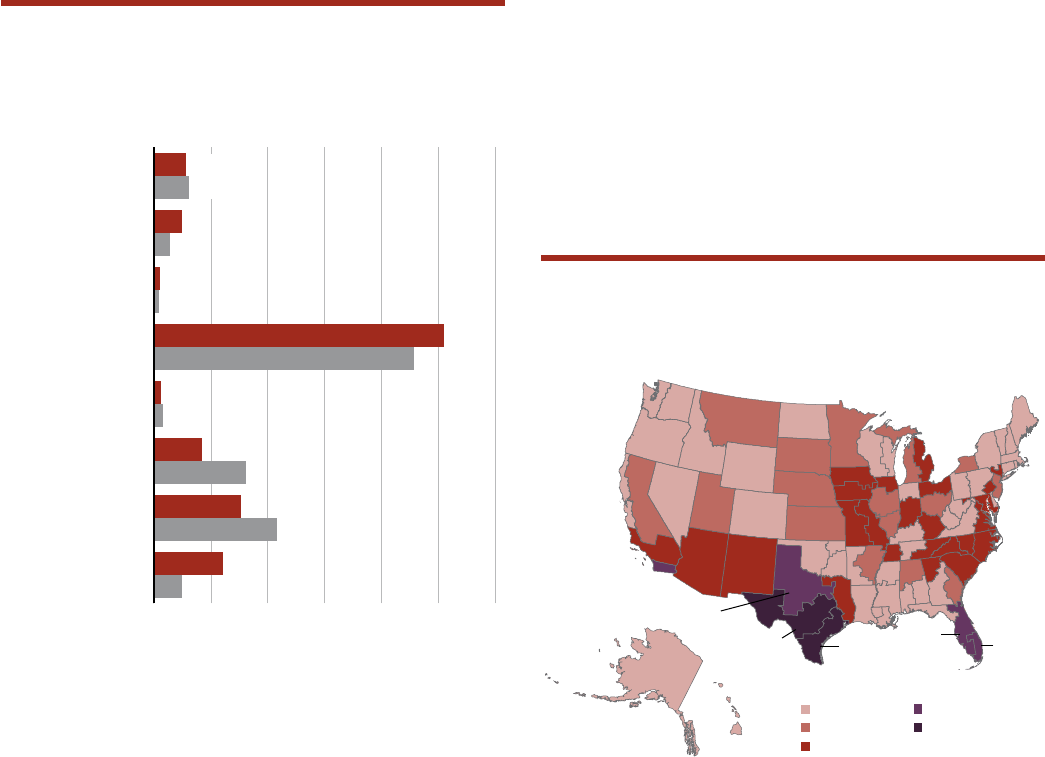
FEDERAL JUSTICE STATISTICS, 2022 | JANUARY 2024 15
Persons committed for a drug offense made up less
than half of federal prisoners at fiscal year-end 2022
At fiscal year-end 2012 and 2022, more federal prisoners
were serving time for a drug offense than for any other
type of offense (figure 8). A drug offense was the
most serious commitment offense for 46% of federal
prisoners in 2022, down from 51% in 2012. During this
10-year period, persons serving time for a weapons
offense increased from 15% to 22% of federal prisoners.
Persons committed for a nonregulatory public order
offense increased from 8% to 16%, mostly due to an
increase in sex offenses. Persons committed for a violent
offense remained at 6%, and persons committed for an
immigration offense decreased from 12% to 5%.
Five judicial districts committed 21% of all persons in
federal prison at fiscal year-end 2022
At fiscal year-end 2022, more than a fifth (21%) of
persons in federal prison were committed from five
districts: Texas Southern (7,363), Texas Western (7,230),
Texas Northern (5,635), Florida Middle (4,813), and
Florida Southern (4,374) (map 2). Courts in three states
(Texas, California, and Florida) committed 30% of all the
persons in federal prison at fiscal year-end 2022.
Nearly 1 in 6 federally sentenced persons in the BOP
were non-U.S. citizens at fiscal year-end 2022
At fiscal year-end 2022, 9% of federally sentenced
persons were citizens of Mexico, 2% were citizens
of South American countries, 2% were citizens of
Caribbean countries, and 2% were citizens of Central
FIGURE 8
Federally sentenced persons in the custody of the Federal
Bureau of Prisons, by most serious commitment offense,
fiscal year-end 2012 and 2022
Note: Data are based on the offense with the longest sentence imposed at
conviction. The unit of count is the individual, federally sentenced person
in the custody of the Federal Bureau of Prisons (BOP) on September 30,
2012 and 2022. Includes persons sentenced in U.S. district court. Excludes
persons sentenced to the BOP by the District of Columbia Superior Court,
military prisoners transferred to BOP facilities to serve their sentence, U.S.
citizen prisoners transferred to the United States from another country
to serve their sentence closer to home, and persons convicted of a state
offense but serving time in a federal prison for their security needs.
Percentages are based on nonmissing data. There were 1,335 records
missing offense type in 2012 and 359 missing offense type in 2022. See
appendix table 7 for percentages.
a
Includes burglary, larceny, motor vehicle theft, arson, transportation
of stolen property, and other property offenses, such as destruction of
property and trespassing.
b
Includes nonregulatory violations concerning tax law (tax fraud), bribery,
perjury, national defense, escape, racketeering and extortion, gambling,
liquor, mailing or transporting obscene materials, traffic, migratory birds,
conspiracy, aiding and abetting, jurisdiction, and other offenses.
Source: Bureau of Justice Statistics, based on data from the Federal Bureau
of Prisons, SENTRY database, fiscal year-end 2012 and 2022.
Most serious commitment offense
0 10 20 30 40 50 60
Immigration
Weapons
Other public order
b
Regulatory public order
Drug
Other property
a
Fraudulent property
Violent
Percent
2012
2022
MAP 2
Federally sentenced persons in the custody of the Federal
Bureau of Prisons, by judicial district of commitment,
fiscal year-end 2022
Note: The Federal Bureau of Prisons (BOP) had custody of 137,603 federally
sentenced persons on September 30, 2022. The unit of count is the
individual, federally sentenced person in the custody of the BOP. Includes
persons sentenced in U.S. district court. Excludes persons sentenced to
the BOP by the District of Columbia Superior Court, military prisoners
transferred to BOP facilities to serve their sentence, U.S. citizen prisoners
transferred to the United States from another country to serve their
sentence closer to home, and persons convicted of a state offense but
serving time in a federal prison for their security needs. The map shows the
number of persons in BOP custody by the federal judicial district in which
they received their sentence to the BOP. Not shown: District of Columbia
(613), Guam (47), Northern Mariana Islands (22), Puerto Rico (2,634), and
U.S. Virgin Islands (108). See appendix table 8 for counts.
Source: Bureau of Justice Statistics, based on data from the Federal Bureau
of Prisons, SENTRY database, fiscal year-end 2022.
Florida
Southern
(4,374)
Florida
Middle
(4,813)
Texas
Southern
(7,363)
Texas
Western
(7,230)
Texas Northern
(5,635)
3,000–5,999
6,000 or more
999 or fewer
1,000–1,499
1,500–2,199

FEDERAL JUSTICE STATISTICS, 2022 | JANUARY 2024 16
American countries (table 10). From fiscal year-end
2012 to 2022, the portion of federal prisoners who were
non-U.S. citizens decreased from 26% to 15%. During
that period, the number of Mexican citizens in prison
decreased by an average of 10% annually. The number of
Canadian citizens in prison decreased by an average of
8% annually.
TABLE 10
Federally sentenced persons in the custody of the Federal Bureau of Prisons, by demographic characteristics, fiscal
year-end 2012 and 2022
Demographic characteristic
2012 2022
Average annual
percent change,
2012–2022
a
Number Percent Number Percent
Total 194,511 100% 137,603 100% -3.4%
Sex
Male 181,982 93.6% 128,526 93.4% -3.4%
Female 12,529 6.4 9,077 6.6 -3.2
Race/ethnicity
White
b
52,097 26.8% 41,678 30.3% -2.2%
Black
b
67,774 34.8 48,879 35.5 -3.2
Hispanic 68,294 35.1 41,652 30.3 -4.8
Asian/Native Hawaiian/Other Pacific Islander
b
2,796 1.4 1,838 1.3 -4.1
American Indian/Alaska Native
b
3,550 1.8 3,556 2.6 0
Age
19 or younger 374 0.2% 95 0.1% -12.8%
20–24 9,975 5.1 4,854 3.5 -6.9
25–29 25,143 12.9 14,130 10.3 -5.6
30–34 37,685 19.4 22,810 16.6 -4.9
35–39 36,321 18.7 24,642 17.9 -3.8
40–44 29,819 15.3 24,442 17.8 -2.0
45–49 21,574 11.1 17,512 12.7 -2.1
50–54 14,882 7.7 12,229 8.9 -1.9
55–59 9,207 4.7 7,931 5.8 -1.5
60–64 5,260 2.7 4,764 3.5 -1.0
65 or older 4,271 2.2 4,194 3.1 -0.2
Median age 38 yrs. ~ 40 yrs. ~ ~
Citizenship
U.S. citizen 143,126 73.6% 116,345 84.6% -2.1%
Non-U.S. citizen 51,308 26.4 21,254 15.4 -8.4
Country/region of citizenship
North America 189,576 97.5% 133,612 97.1% -3.4%
United States 143,126 73.6 116,345 84.6 -2.1
Mexico 37,313 19.2 12,527 9.1 -10.3
Canada 376 0.2 164 0.1 -8.0
Caribbean Islands
c
4,773 2.5 2,359 1.7 -6.8
Central America
c
3,988 2.1 2,217 1.6 -5.7
South America
c
2,523 1.3 2,531 1.8 0.0
Asia and Oceania
c
1,253 0.6 665 0.5 -6.1
Europe
c
541 0.3 384 0.3 -3.4
Africa
c
541 0.3 407 0.3 -2.8
Note: Details may not sum to totals due to rounding. The unit of count is the individual, federally sentenced person in the custody of the Federal Bureau
of Prisons (BOP) on September 30, 2012 and 2022. Includes persons sentenced in U.S. district court. Excludes persons sentenced to the BOP by the District
of Columbia Superior Court, military prisoners transferred to BOP facilities to serve their sentence, U.S. citizen prisoners transferred to the United States
from another country to serve their sentence closer to home, and persons convicted of a state offense but serving time in a federal prison for their security
needs. Percentages are based on nonmissing cases. There were 77 records missing citizenship in 2012 and 4 missing citizenship in 2022.
~Not applicable.
a
Calculated using fiscal year-end counts in 2012 and in 2022. See Methodology.
b
Excludes persons of Hispanic origin (e.g., “white” refers to non-Hispanic white persons and “black” refers to non-Hispanic black persons). Defendants self-
reported race and ethnicity during the presentence interview. Information was collected for one race and one ethnicity category.
c
Countries aggregated by region.
Source: Bureau of Justice Statistics, based on data from the Federal Bureau of Prisons, SENTRY database, fiscal year-end 2012 and 2022.

FEDERAL JUSTICE STATISTICS, 2022 | JANUARY 2024 17
The number of prisoners age 65 or older decreased
less than 1% from fiscal year-end 2012 to 2022
The median age of prisoners was 40 years at fiscal year-
end 2022, compared to 38 years at fiscal year-end 2012.
The number of prisoners age 65 or older decreased less
than 1%, from 4,271 prisoners in 2012 to 4,194 prisoners
in 2022. Persons age 65 or older made up about 3% of all
federal prisoners in 2022, compared to 2% in 2012.
The type of commitment offense varied by race or
ethnicity at fiscal year-end 2021
Hispanic, black, white, and Asian/Native Hawaiian/
Other Pacific Islander persons in federal prison at fiscal
year-end 2022 were most commonly committed for
drug offenses (table 11). More Hispanics were serving
time for a drug (24,745) or immigration (6,329) offense
than members of any other racial or ethnic group. More
black persons were serving time for a weapons (18,153)
or violent (2,736) offense than persons of any other race
or ethnicity. The largest number of persons serving time
for a public order offense (13,987) were white. Among
persons who were American Indian or Alaska Native,
the most common commitment offenses were violent
(2,016), drug (578), and weapons (482) offenses.
TABLE 11
Federally sentenced persons in the custody of the Federal Bureau of Prisons, by most serious commitment offense and
race or ethnicity, fiscal year-end 2022
Most serious
commitment offense White* Black* Hispanic
Asian/Native Hawaiian/
Other Pacific Islander*
American Indian/
Alaska Native*
Violent 2,325 2,736 1,122 89 2,016
Property 1,972 1,852 867 219 111
Drug 16,476 20,234 24,745 828 578
Public order 13,987 5,586 4,096 453 332
Weapons 6,523 18,153 4,430 233 482
Immigration 238 201 6,329 6 25
Note: Data are based on the offense with the longest sentence imposed at conviction. The unit of count is the individual, federally sentenced person in the
custody of the Federal Bureau of Prisons (BOP) on September 30, 2022. Includes persons sentenced in U.S. district court. Excludes persons sentenced to the
BOP by the District of Columbia Superior Court, military prisoners transferred to BOP facilities to serve their sentence, U.S. citizen prisoners transferred to
the United States from another country to serve their sentence closer to home, and persons convicted of a state offense but serving time in a federal prison
for their security needs. There were 359 records missing offense type.
*Excludes persons of Hispanic origin (e.g., “white” refers to non-Hispanic white persons and “black” refers to non-Hispanic black persons). Defendants self-
reported race and ethnicity during the presentence interview. Information was collected for one race and one ethnicity category.
Source: Bureau of Justice Statistics, based on data from the Federal Bureau of Prisons, SENTRY database, fiscal year-end 2022.

Time served in federal prison
During FY 2022, a total of 39,199 persons were released
from federal prison for the first time after serving a
sentence imposed in U.S. district court. Of these, 26,048
persons were released by standard means (table 12).
Standard releases include the most common methods of
exiting prison, such as upon serving an entire sentence,
serving an entire sentence with good time, and release
to parole. Persons released in FY 2022 served a median
of 39 months. Persons released after serving sentences
for nonregulatory public order offenses including
sex offenses (median time served 66 months) served
the most time, more than those released after serving
sentences for violent offenses (56 months) or drug
offenses (53 months).
Among persons released from federal prison, males
(40months) served more time than females (28
months). Older persons served more time before release
than younger persons, and U.S. citizens (47 months)
TABLE 12
Time served by persons released by standard means from the Federal Bureau of Prisons, by commitment offense and
demographic characteristics, FY 2022
Demographic
characteristic
Number
of persons
released
Median time served
All offenses Violent
Property
Drug
Public order
Weapons ImmigrationFraudulent Other
a
Regulatory Other
b
Total 26,048 39.2mos. 55.5 mos. 28.1 mos. 25.9 mos. 52.8 mos. 25.6 mos. 65.6 mos. 42.7 mos. 15.3 mos.
Sex
Male 24,194 39.7 mos. 58.1mos. 28.2mos. 29.0mos. 54.7 mos. 27.1mos. 66.5 mos. 43.4 mos. 15.3mos.
Female 1,831 28.2 30.7 22.2 12.0 35.0 20.4 39.2 31.6 12.8
Race/ethnicity
White
c
5,754 48.6mos. 53.7 mos. 28.1 mos. 25.6 mos. 53.8 mos. 25.6 mos. 68.2 mos. 40.9 mos. 15.3 mos.
Black
c
7,765 51.1 81.4 30.6 23.3 61.4 27.3 70.3 43.9 15.8
Hispanic 11,491 28.1 57.4 23.9 31.5 51.1 25.6 61.2 42.2 15.3
Asian/Native Hawaiian/
Other Pacific Islander
c
371 36.7 33.4 26.8 12.8 51.2 29.4 39.2 43.5 20.0
American Indian/
Alaska Native
c
644 35.0 38.5 26.8 30.9 42.6 22.8 23.7 40.7 15.3
Age at release
19 or younger 54 12.8 mos. ^ ^ ^ ^ ^ ^ ^ 12.8 mos.
20–24 1,493 20.5 25.2 mos. 12.7 mos. 11.9 mos. 25.6 mos. 16.1 mos. 20.8 mos. 25.6 mos. 12.8
25–29 3,500 30.6 44.0 22.1 26.0 34.9 25.5 51.1 32.4 13.6
30–34 4,827 36.0 45.2 30.7 23.1 51.1 26.0 61.3 40.7 14.5
35–39 4,721 41.0 56.6 27.1 35.8 56.1 23.9 68.7 50.8 15.3
40–44 4,058 45.2 67.8 28.3 31.5 64.0 22.5 74.3 52.4 15.3
45–49 2,809 50.3 90.2 30.7 31.6 71.6 25.6 81.8 62.3 17.0
50–54 1,939 51.2 68.0 35.0 25.6 74.2 26.8 81.7 75.7 17.8
55–59 1,228 52.0 81.8 31.5 25.5 75.9 30.6 74.8 102.23 18.7
60–64 773 59.7 78.8 22.1 29.0 76.3 30.6 82.7 102.83 23.0
65 or older 623 63.1 113.8 35.4 23.0 89.1 30.7 66.5 151.4 12.8
Citizenship
U.S. citizen 17,740 47.3mos. 56.3 mos. 27.3 mos. 25.8 mos. 53.8 mos. 25.1 mos. 66.5 mos. 42.6 mos. 15.3 mos.
Non-U.S. citizen 8,215 25.5 48.6 28.2 28.1 51.2 28.1 51.1 51.1 15.3
Note: Includes persons committed by U.S. district court and released during fiscal year 2022 from the Federal Bureau of Prisons (BOP) by the most common
ways persons exit prison, such as upon serving an entire sentence, serving an entire sentence with good time, and release to parole. Excludes persons
sentenced to the BOP by the District of Columbia Superior Court, military prisoners transferred to BOP facilities to serve their sentence, U.S. citizen prisoners
transferred to the United States from another country to serve their sentence closer to home, persons convicted of a state offense but serving time in a
federal prison for their security needs, and persons released from federal prison by extraordinary means (death, commutation, or transfer). Time served is
calculated as the interval between a person’s admission to and first release from BOP custody, plus any jail time served and credited. There were 23 records
missing the person’s sex, 23 missing the person’s race or ethnicity, 23 missing the person’s age at release, and 93 missing the person’s citizenship status.
^Estimate is based on 10 or fewer cases.
a
Includes burglary, larceny, motor vehicle theft, arson, transportation of stolen property, and other property offenses, such as destruction of property
andtrespassing.
b
Includes nonregulatory violations concerning tax law (tax fraud), bribery, perjury, national defense, escape, racketeering and extortion, gambling, liquor,
mailing or transporting obscene materials, traffic, the Migratory Bird Treaty Act, conspiracy, aiding and abetting, jurisdiction, and other offenses.
c
Excludes persons of Hispanic origin (e.g., “white” refers to non-Hispanic white persons and “black” refers to non-Hispanic black persons). Persons self-
reported race and ethnicity during the presentence interview. Information was collected for one race and one ethnicity category.
Source: Bureau of Justice Statistics, based on data from the Federal Bureau of Prisons, SENTRY database, fiscal year 2022.
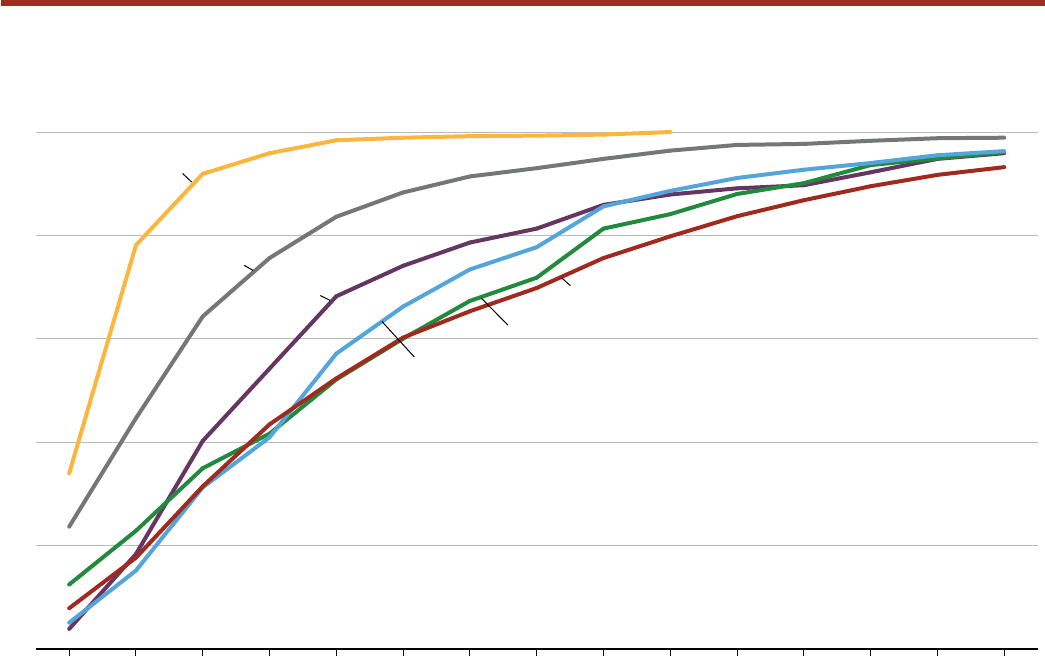
FEDERAL JUSTICE STATISTICS, 2022 | JANUARY 2024 19
served more time than non-U.S. citizens (26 months).
Black persons exiting federal prison in FY 2022 had
served more time (a median of 51 months) for their
commitment offense than persons of any other racial or
ethnic group (a median of 28 to 49 months). This was
true in general and for most offense types. Black persons
served the most time for violent (81 months), drug (61
months), and nonregulatory public order (70 months)
offenses. American Indian or Alaska Native persons
served more time for drug (43 months) and weapons
offenses (41 months) than for any other type of offense.
The greatest difference in time served between white and
black persons was for violent offenses (white persons
served 27 fewer months), followed by drug offenses
(white persons served 10 fewer months).
About 34% of prisoners first released in FY 2022 who
had been committed for an immigration offense and
24% of those who had been committed for a property
offense were first released after serving 1 year or less in
prison (figure 9). Eight percent of prisoners who had
been committed for violent offenses and 5% of persons
committed for drug offenses and who were first released
in FY 2022 were released after serving 1 year or less.
Eighty percent of persons serving time for a violent
offense and first released in FY 2022 had served 10 years
or less in prison.
FIGURE 9
Federally sentenced persons released by standard means from the Federal Bureau of Prisons, by most serious
commitment offense and time served, FY 2022
Cumulative percent of persons released
0
20
40
60
80
100
At least
15 years
141312111098765432Up to 1 year
Immigration
Weapons
Public order
Drug
Property
Violent
Time served
Note: Includes persons committed by a U.S. district court and released during fiscal year 2022 from the Federal Bureau of Prisons (BOP) by the most
common ways persons exit prison, such as upon serving an entire sentence, serving an entire sentence with good time, and release to parole. Excludes
persons sentenced to the BOP by the District of Columbia Superior Court, military prisoners transferred to BOP facilities to serve their sentence, U.S. citizen
prisoners transferred to the United States from another country to serve their sentence closer to home, persons convicted of a state offense but serving
time in a federal prison for their security needs, and persons released from federal prison by extraordinary means (death, commutation, or transfer). Time
served is calculated as the interval between a person’s admission to and first release from BOP custody, plus any jail time served and credited. See appendix
table 9 for percentages.
Source: Bureau of Justice Statistics, based on data from the Federal Bureau of Prisons, SENTRY database, fiscal year 2022.

FEDERAL JUSTICE STATISTICS, 2022 | JANUARY 2024 20
Federal supervision in the community
The Administrative Office of the U.S. Court’s (AOUSC)
Probation and Pretrial Services system oversees the
supervision of persons released before trial and persons
supervised in the community after being convicted.
Federal probation officers monitor compliance with the
court-ordered conditions of supervision.
90% of persons under federal supervision in the
community at fiscal year-end 2022 had been
released from prison
At fiscal year-end 2022, a total of 120,859 persons were
under federal supervision in the community (table 13).
About 90% of persons under federal community
supervision were on supervised release (108,697). The
remaining 10% were on probation (12,162). About 85%
of all persons under community supervision in 2022
were male, and 15% were female. Black (40,640) and
white (39,134) released persons together made up 68%
of persons under federal supervision in the community.
The median age of released persons on probation was
40 years. The median age of released persons under
supervised release was 43 years. Four percent ofpersons
under post-conviction federal supervision were
non-U.S.citizens.
The percentage of persons admitted to supervision for
drug offenses made up a slightly smaller share of persons
under federal supervision, decreasing from 48% at fiscal
year-end 2012 to 43% at fiscal year-end 2022 (figure 10).
During that period, the percentage of persons under
supervision for fraudulent property offenses decreased
from 18% to 12% of persons under supervision, while
the percentage of persons committed for other public
order offenses increased from 9% to 14%, mostly due to
an increase in sex offenses. The percentage of persons
committed for weapons offenses increased from 12% to
17% of persons under supervision.
FIGURE 10
Persons under federal supervision in the community, by
commitment offense, fiscal year-end 2012 and 2022
Note: Data are based on the offense with the longest sentence. The
unit of count is a person serving a term under federal supervision in
the community. Percentages are based on nonmissing data. There were
264 records missing commitment offense in 2012 and 237 missing
commitment offense in 2022. See appendix table 10 for percentages.
a
Includes burglary, larceny, motor vehicle theft, arson, transportation
of stolen property, and other property offenses, such as destruction of
property and trespassing.
b
Includes nonregulatory violations concerning tax law (tax fraud), bribery,
perjury, national defense, escape, racketeering and extortion, gambling,
liquor, mailing or transporting obscene materials, traffic, migratory birds,
conspiracy, aiding and abetting, jurisdiction, and other offenses.
Source: Bureau of Justice Statistics, based on data from the Administrative
Office of the U.S. Courts, Probation and Pretrial Services Automated Case
Tracking System, fiscal year-end 2012 and 2022.
Commitment offense
0 10 20 30 40 50
Immigration
Weapons
Other public order
b
Regulatory public order
Drug
Other property
a
Fraudulent property
Violent
Percent
2012
2022

FEDERAL JUSTICE STATISTICS, 2022 | JANUARY 2024 21
TABLE 13
Persons under post-conviction federal supervision, by demographic characteristics, fiscal year-end 2022
Demographic characteristic
All persons
a
Probation Supervised release
b
Number Percent Number Percent Number Percent
Total 120,859 100% 12,162 10.1% 108,697 89.9%
Sex
Male 101,909 84.5% 7,696 64.4% 94,213 86.7%
Female 18,729 15.5 4,247 35.6 14,482 13.3
Race/ethnicity
White
c
39,194 33.3% 4,725 41.3% 34,469 32.5%
Black
c
40,640 34.6 2,947 25.7 37,693 35.5
Hispanic 32,521 27.6 3,042 26.6 29,479 27.8
Asian/Native Hawaiian/
Other Pacific Islander
c
2,510 2.1 417 3.6 2,093 2.0
American Indian/
Alaska Native
c
2,776 2.4 322 2.8 2,454 2.3
Age
19 or younger 156 0.1% 95 0.8% 61 0.1%
20–24 4,305 3.6 1,067 8.9 3,238 3.0
25–29 10,690 8.9 1,556 13.0 9,134 8.4
30–34 16,438 13.6 1,647 13.8 14,791 13.6
35–39 18,031 15.0 1,529 12.8 16,502 15.2
40–44 19,382 16.1 1,380 11.6 18,002 16.6
45–49 15,888 13.2 1,133 9.5 14,755 13.6
50–54 12,586 10.4 1,055 8.8 11,531 10.6
55–59 9,206 7.6 873 7.3 8,333 7.7
60–64 6,519 5.4 701 5.9 5,818 5.4
65 or older 7,435 6.2 905 7.6 6,530 6.0
Median age ~ 43 yrs. ~ 40 yrs. ~ 43 yrs.
Citizenship
U.S. citizen 115,965 96.2% 11,302 94.6% 104,663 96.4%
Non-U.S. citizen 4,592 3.8 649 5.4 3,943 3.6
Country/region of citizenship
North America 119,284 98.9% 11,714 98.0% 107,570 99.1%
United States 115,965 96.2 11,302 94.6 104,663 96.4
Mexico 1,496 1.2 201 1.7 1,295 1.2
Canada 32 <0.1 8 0.1 24 0.0
Caribbean Islands
d
1,275 1.1 110 0.9 1,165 1.1
Central America
d
516 0.4 93 0.8 423 0.4
South America
d
259 0.2 40 0.3 219 0.2
Asia and Oceania
d
582 0.5 123 1.0 459 0.4
Europe
d
187 0.2 27 0.2 160 0.2
Africa
d
245 0.2 47 0.4 198 0.2
Note: The unit of count is a person serving a term under federal supervision in the community on September 30, 2022. Percentages are based on
nonmissing cases. There were 223 records missing the defendant’s age, 221 missing the defendant’s sex, 3,218 missing the defendant’s race or ethnicity,
and 302 missing the defendant’s citizenship status.
~Not applicable.
a
Includes persons for whom characteristics were unknown.
b
Includes persons on parole supervision.
c
Excludes persons of Hispanic origin (e.g., “white” refers to non-Hispanic white persons and “black” refers to non-Hispanic black persons).
d
Countries aggregated by region.
Source: Bureau of Justice Statistics, based on data from the Administrative Office of the U.S. Courts, Probation and Pretrial Services Automated Case
Tracking System, fiscal year-end 2022.

FEDERAL JUSTICE STATISTICS, 2022 | JANUARY 2024 22
Methodology
This report uses data from the Federal Justice Statistics
Program (FJSP), a collection from the Bureau of Justice
Statistics (BJS). The FJSP receives administrative
data files from six federal criminal justice agencies.
Data represent the federal criminal case-processing
stages from arrest to imprisonment and release. BJS
standardizes this information to maximize comparability
across and within agencies over time. This includes:
Applying, where possible, the person-case as the
primary unit of count. Exceptions include at arrest,
where the unit of count is the individual suspect;
at sentencing under federal sentencing guidelines,
where the unit of count is the sentencing event; and at
imprisonment, where the unit of count is the prisoner.
The unit of analysis in this report is a combination
of a person and arrest, matter, or case. For example,
if a person is arrested and booked twice during the
indicated period, such as with a supervision violation
and again with a new offense, this is counted as
two arrests or bookings. The unit of analysis for
incarceration, probation, parole, or other supervised
release is a person entering custody or supervision,
a person leaving custody or supervision, or a person
in custody or supervision at yearend. For example,
if a person is convicted in two concurrent cases and
committed once to the custody of the Federal Bureau
of Prisons (BOP) during the indicated period, they are
counted as one admission to a term of incarceration.
Delineating the fiscal year (October 1 through
September 30) as the period for reported events.
Applying a uniform offense classification across
agencies. Offense categories for federal arrestees
are based on the FBI’s National Crime Information
Center offense classifications, which are aggregated
into the offense categories shown in the report.
Offense categories for persons in prison are based on
offense classifications used by the BOP, while offense
categories for those on federal supervision are based
on offense classifications used by Administrative
Office of the U.S. Courts (AOUSC). Data from the
Executive Office for U.S. Attorneys is classified using
U.S. Code titles and sections and then aggregated into
the offense categories used in the tables.
Classifying dispositions and sentences imposed.
FJSP data sources
U.S. Marshals Service: The Justice Detainee Information
System provides information on suspects arrested for
federal offenses. Suspects are counted more than once in
a fiscal year if they are arrested multiple times during the
period. This report uses the most serious arrest offense
that suspects were booked for by the deputy U.S. marshal.
Deputy U.S. marshals take federal suspects who have
been charged with a crime into custody (which includes
booking, processing, and detaining the suspects), oversee
court security, and coordinate prisoner transportation,
among other duties.
The 2020–2022 file is based on the custody start date
being between October 1, 2019 and September 30, 2022
(fiscal year). The fiscal year files prior to 2020 were
created using the arrest date. There are slightly more
records with a nonmissing custody date than with a
nonmissing arrest date. This is because not all bookings
have the arrest date recorded. To ensure all bookings
are captured, the custody date is used. Some arrests that
would have been incorporated in previous years are
excluded from the 2020–2022 file because the associated
custody start date is outside of the fiscal year. Similarly,
some arrests occurring outside of the fiscal year are
retained because they are associated with a custody start
date during the fiscal year.
Drug Enforcement Administration: The Defendant
Statistical System contains data on suspects arrested
within the United States by Drug Enforcement
Administration (DEA) agents. The data include
information on the characteristics of persons arrested
and the type of drug for which they were arrested.
Suspects are counted more than once in a fiscal year
if they are arrested multiple times by the DEA during
theperiod.
Executive Office for U.S. Attorneys: The Legal
Information Office Network System database contains
information on the investigation and prosecution of
suspects in criminal matters received and concluded and
criminal cases filed and adjudicated by U.S. attorneys.
Suspects are counted more than once in a fiscal year
if they are involved in multiple matters received and
concluded during the period. A matter is defined as a
referral in which an attorney spends 1 hour or more
investigating. The lead charge is used to classify the
most serious offense at referral and is defined as the
substantive statute that is the primary basis of referral.

FEDERAL JUSTICE STATISTICS, 2022 | JANUARY 2024 23
Administrative Office of the U.S. Courts: The Criminal
Master File contains information about the criminal
proceedings against defendants whose cases were filed
and adjudicated in U.S. district courts. A criminal
case is initiated by the government, usually through
the U.S. attorney’s office in coordination with a law
enforcement agency. A criminal case is adjudicated
when a defendant is convicted following plea or trial,
acquittal of the defendant after trial, or dismissal of the
case. The Criminal Master File includes information on
cases involving felonies and Class A and B misdemeanors
handled by U.S. district judges.
5
Offenses are based on the most serious charged offense,
as determined by the probation officer responsible
for interviewing the defendant. The probation officer
classifies the major offense charged into AOUSC four-
digit offense codes, which are maintained and updated by
the AOUSC. For defendants charged with more than one
offense on an indictment, the probation officer chooses
the offense carrying the most severe penalty or, in the
case of two or more charges carrying the same penalty,
the one with the highest offense severity. The offense
severity level is determined by the AOUSC, which ranks
offenses according to the maximum sentence, type of
crime, and maximum fine amount.
This report also uses AOUSC data from the Pretrial
Services Automated Case Tracking System (PACTS),
which contains information on defendants interviewed
and supervised by pretrial services. These data are
used to describe background characteristics of persons
who are arraigned. PACTS data are also used to
describe persons under post-sentencing supervision in
thecommunity.
5
A felony is classified as an offense for which the maximum term
of imprisonment is more than 1 year in prison. Offenses classified
as misdemeanors include those for which the maximum term of
imprisonment is less than 1 year in prison. Class A misdemeanors
include offenses for which the maximum term of imprisonment is 1
year or less but more than 6 months in prison. Class B misdemeanors
include offenses for which the maximum term of imprisonment is 6
months or less but more than 30 days in prison.
U.S. Sentencing Commission: The Monitoring Database
contains information on criminal defendants sentenced
pursuant to the provisions of the Sentencing Reform
Act of 1984. Data files are limited to defendants whose
court records have been obtained by the U.S. Sentencing
Commission.
Federal Bureau of Prisons: The SENTRY database
contains information on all federally sentenced persons
admitted to or released from federal prison during a
fiscal year and persons in federal prison at fiscal year-
end (September 30). The prisoner count reported by the
FJSP differs from what is reported by the BOP, although
data are from the same source (SENTRY). For example,
the BOP reported 159,090 prisoners as of September
30, 2022. (See https://www.bop.gov/about/statistics/
population_statistics.jsp.) The FJSP starts with data
extracted from SENTRY that differs slightly from this
total (158,437). The difference (653 records) may be due
to the timing of when the data request was made.
The data reported by the BOP draw on a more current
extract of the database that includes updated records.
Of the 158,437 records, 16,965 records were removed
from analysis because the prisoner was not listed
at a BOP custodial facility. The excluded records
included designations to community confinement,
home confinement, a hospital, Immigration and
Customs Enforcement detention, material witness, and
presentence admission. Next, 988 records were excluded
due to missing commitment offense, and 2,493 were
excluded because the prisoner was sentenced by the
District of Columbia Superior Court. Finally, 388 records
were removed because the prisoner was held as a state
boarder, a foreign treaty transfer, or serving a sentence
from a military court commitment.

FEDERAL JUSTICE STATISTICS, 2022 | JANUARY 2024 24
Of the 158,437 prisoners reported by the BOP in custody
on September 30, 2022, a total of 137,603 (87% of the
BOP population) met the criteria as federally sentenced
prisoners (figure 11).
The average annual percent change detailed in table 10
and appendix tables 1 and 3 measures the average rate of
growth (or decline) in the number per year between 2012
and 2022. The following formula is used:
1
[(
n
th
year
)
n
first year
− 1
]
× 100
The total average annual percent change in the BOP
custody population (2012–2022) is computed as follows:
[(
137,603
)
1
2022 − 2012
− 1
]
× 100 = [(0.70743
0.10
) − 1] × 100 =
194,511
(0.965981−1)×100 ≈ -3.4%
Other resources
FJSP data are available in the Federal Criminal Case
Processing Statistics Tool, an interactive BJS web tool that
permits users to query the federal data and download
the results.
6
It provides statistics by the stage of the
federal criminal case process, including law enforcement,
prosecution and courts, and incarceration. Users can
also generate queries by the title and section of the U.S.
criminal code.
6
BJS’s Federal Criminal Case Processing Statistics (FCCPS) query tool
is available at https://fccps.bjs.ojp.gov.
FIGURE 11
Universe of prisoners held under the Federal Bureau of
Prisons’ jurisdiction, fiscal year-end 2022
Note: 158,437 persons were under the Federal Bureau of Prisons’
jurisdiction at fiscal year-end 2022. Excludes records missing commitment
offense; persons sentenced to the Federal Bureau of Prisons (BOP) by the
District of Columbia Superior Court, military prisoners transferred to BOP
facilities to serve their sentence, U.S. citizen prisoners transferred to the
United States from another country to serve their sentence closer to home,
persons convicted of a state offense but serving time in a federal prison for
their security needs, and prisoners designated to community confinement,
home confinement, presentence detention, a hospital, or Immigration and
Customs Enforcement detention.
*Includes federally sentenced prisoners held in private facilities.
Source: Bureau of Justice Statistics, based on data from the Federal Bureau
of Prisons, SENTRY database, fiscal year-end 2022.
0
50 100 150 200
All other
prisoners*
Federally sentenced prisoners in the
Federal Bureau of Prisons
20,834137,603
Number (in thousands)

FEDERAL JUSTICE STATISTICS, 2022 | JANUARY 2024 25
APPENDIX TABLE 1
Counts for figure 1: Suspects and defendants processed in the federal criminal justice system, FY 2000–2022
Fiscal year Suspects investigated
a
Suspects arrested
b
Defendants charged
c
Defendants convicted
d
Defendants
sentenced to prison
d
2000 123,559 115,025 83,251 68,156 50,451
2001 121,818 116,777 82,614 68,533 51,057
2002 124,335 121,610 87,727 71,798 53,682
2003 130,078 124,708 92,085 75,805 57,629
2004 141,215 138,223 92,645 74,782 58,106
2005 137,590 137,411 91,578 78,042 61,151
2006 133,935 144,072 87,650 79,904 63,699
2007 138,410 151,844 88,742 79,356 62,893
2008 178,570 173,463 91,835 82,823 64,529
2009 188,341 181,726 97,513 86,975 67,499
2010 187,916 179,034 99,921 89,902 69,494
2011 187,735 177,547 103,021 92,240 70,049
2012 190,596 172,248 92,789 87,908 67,582
2013 190,267 188,164 89,843 82,838 64,390
2014 160,505 165,265 80,051 78,155 60,626
2015 157,313 153,478 78,742 72,427 56,018
2016 151,994 151,460 76,276 69,487 54,274
2017 143,684 142,008 75,936 68,553 52,898
2018 195,842 195,771 86,024 72,588 54,112
2019 203,030 206,630 91,520 78,256 56,366
2020 135,993 120,112 73,256 65,848 44,429
2021 105,121 78,068 73,835 58,271 43,157
2022 102,329 96,857 67,807 65,470 49,897
Average annual
percent change,
2012–2022
e
-6.0% -5.6% -3.1% -2.9% -3.0%
Percent change,
2021–2022 -2.7 24.1 -8.2 12.4 15.6
a
Suspects in matters investigated by U.S. attorneys. Suspects investigated in more than one matter are counted separately.
b
Suspects arrested by federal law enforcement. Each arrest is counted separately, so suspects with more than one arrest are counted more than once.
Excludes District of Columbia Superior Court arrests. For 2020 to 2022 arrests, the custody start date is used instead of the arrest date (as in prior years)
because not all bookings in 2020 to 2022 had arrest dates, due to the U.S. Marshals Service’s transition to a new data system. The custody date is used to
ensure all bookings are enumerated, including records that are missing an arrest date. See Methodology.
c
Defendants charged with a felony or a misdemeanor offense in U.S. district court. Defendants charged in more than one case are counted separately.
d
Defendants in cases adjudicated with a felony or a misdemeanor offense in U.S. district court. Defendants in more than one adjudicated case are
countedseparately.
e
Average annual percent change measures the change over a period of 2 years or more. It shows the average rate of increase (or decrease) per year from
2012 to 2022. See Methodology.
Source: Bureau of Justice Statistics, based on data from the U.S. Marshals Service, Justice Detainee and CAPTURE information systems; Executive Office for
U.S. Attorneys, National Legal Information Office Network System database; and Administrative Office of the U.S. Courts, Criminal Master File, fiscal years
2000–2022.

FEDERAL JUSTICE STATISTICS, 2022 | JANUARY 2024 26
APPENDIX TABLE 2
Counts for figures 2 and 3: Suspects investigated and arrested and defendants charged, convicted, and sentenced to
prison in the federal criminal justice system, October 1, 2019–September 30, 2022
Month Suspects investigated
a
Suspects arrested
b
Defendants charged
c
Defendants convicted
d
Defendants
sentenced to prison
d
October 2019 16,027 15,687 8,834 7,366 5,297
November 2019 13,576 13,872 7,496 6,426 4,699
December 2019 13,031 14,288 7,684 6,995 4,874
January 2020 15,360 15,205 7,347 7,924 5,508
February 2020 15,996 16,511 7,814 6,852 4,924
March 2020 12,995 12,325 5,300 5,295 3,220
April 2020 6,529 2,369 1,232 2,995 964
May 2020 6,834 3,157 3,006 3,429 1,985
June 2020 8,338 5,426 5,507 5,300 3,578
July 2020 8,727 6,361 6,245 4,429 3,006
August 2020 9,057 7,105 5,729 4,273 3,062
September 2020 9,523 7,806 7,062 4,564 3,312
October 2020 9,926 7,441 7,360 4,894 3,593
November 2020 7,794 5,955 6,193 3,912 2,851
December 2020 7,704 5,832 5,010 4,170 2,928
January 2021 9,209 5,520 4,160 4,448 3,199
February 2021 8,562 5,562 5,925 4,322 3,053
March 2021 10,771 6,877 6,774 5,349 3,885
April 2021 9,544 6,673 6,842 5,295 3,926
May 2021 8,673 6,804 6,496 4,896 3,679
June 2021 8,619 7,022 6,723 5,330 4,063
July 2021 8,165 6,585 5,716 5,083 3,907
August 2021 8,424 6,826 6,147 5,347 4,097
September 2021 7,730 6,971 6,489 5,225 3,976
October 2021 8,258 7,826 5,489 5,890 4,545
November 2021 7,367 7,228 5,339 5,558 4,256
December 2021 6,806 6,783 5,289 4,950 3,763
January 2022 8,537 6,674 4,057 5,041 3,789
February 2022 8,356 7,537 5,286 5,325 4,087
March 2022 10,140 9,292 6,589 5,947 4,703
April 2022 8,998 8,362 6,005 5,426 4,204
May 2022 8,949 8,719 5,893 4,964 3,723
June 2022 8,669 8,676 6,671 5,626 4,224
July 2022 8,036 8,006 5,138 5,067 3,864
August 2022 9,575 9,269 6,126 6,113 4,589
September 2022 8,638 8,485 6,092 5,563 4,150
a
Suspects in matters investigated by U.S. attorneys. Suspects investigated in more than one matter are counted separately.
b
Suspects arrested by federal law enforcement. Each arrest is counted separately, so persons with more than one arrest are counted more than once.
Excludes District of Columbia Superior Court arrests. For 2020 to 2022 arrests, the custody start date is used instead of the arrest date (as in prior years)
because not all bookings in 2020 to 2022 had arrest dates, due to the U.S. Marshals Service’s transition to a new data system. The custody date is used to
ensure all bookings are enumerated, including records that are missing an arrest date. See Methodology.
c
Defendants charged with a felony or a misdemeanor offense in U.S. district court. Defendants charged in more than one case are counted separately.
d
Defendants in cases adjudicated with a felony or a misdemeanor offense in U.S. district court. Defendants in more than one adjudicated case are
countedseparately.
Source: Bureau of Justice Statistics, based on data from the U.S. Marshals Service, CAPTURE information system; Executive Office for U.S. Attorneys, National
Legal Information Office Network System database; and Administrative Office of the U.S. Courts, Criminal Master File, fiscal years 2020–2022.

FEDERAL JUSTICE STATISTICS, 2022 | JANUARY 2024 27
APPENDIX TABLE 3
Counts for figures 4 and 5: Federal and state arrests by the Drug Enforcement Administration involving powder
cocaine, crack cocaine, heroin, other opioids, marijuana, methamphetamine, and other nonopioids, FY 2012–2022
Fiscal year Total Powder cocaine Crack cocaine Heroin
a
Other opioids
b
Marijuana Methamphetamine Other nonopioids
c
2012 31,628 7,386 2,653 3,664 2,269 6,787 6,000 2,869
2013 30,532 6,346 2,113 4,181 2,227 5,862 6,858 2,945
2014 29,549 5,582 1,782 4,852 2,048 5,082 7,005 3,197
2015 31,593 6,017 1,567 6,340 1,918 4,741 8,023 2,932
2016 29,486 5,484 1,455 5,926 1,553 4,213 8,068 2,787
2017 27,223 5,495 1,152 5,452 1,790 3,541 7,280 2,513
2018 27,348 5,198 1,103 5,078 2,170 3,266 8,088 2,445
2019 27,543 4,899 970 4,837 2,598 2,597 9,076 2,566
2020 26,696 4,474 1,217 3,707 2,925 2,576 8,783 3,014
2021 28,224 5,049 1,118 2,661 3,744 2,615 9,412 3,625
2022 26,233 5,065 1,048 1,523 5,375 2,136 8,083 3,003
Average annual
percent change,
2012–2022
d
-1.9% -3.7% -8.9% -8.4% 9.0% -10.9% 3.0% 0.5%
Percent change,
2021–2022 -7.1 0.3 -6.3 -42.8 43.6 -18.3 -14.1 -17.2
Note: The unit of count is an arrest by the Drug Enforcement Administration (DEA). Each arrest for a person is counted separately. Includes state and federal
arrests made by the DEA.
a
Includes heroin, morphine, and opium base.
b
Includes fentanyl, oxycodone, hydrocodone, opioid treatment pharmaceuticals, hydromorphone, Palladone, and oxymorphone.
c
Includes nonopioid pharmaceutical controlled substances, other depressants, sedatives, ephedrine, pseudoephedrine, hallucinogens, synthetic
cannabinoids, other steroids, equipment to manufacture controlled substances, and drug use paraphernalia. Includes drug diversion arrests where drug
type is not indicated.
d
Average annual percent change measures the change over a period of 2 years or more. It shows the average rate of increase (or decrease) in DEA drug
arrests per year from 2012 to 2022.
Source: Bureau of Justice Statistics, based on data from the Drug Enforcement Administration, Defendant Statistical System, fiscal years 2012–2022.

FEDERAL JUSTICE STATISTICS, 2022 | JANUARY 2024 28
APPENDIX TABLE 4
Counts for map 1: Federal arrests, by judicial district, FY 2022
Federal judicial district Number
Total 96,857
Alabama Middle 288
Alabama Northern 604
Alabama Southern 491
Alaska 230
Arizona 11,017
Arkansas Eastern 766
Arkansas Western 281
California Central 1,743
California Eastern 705
California Northern 534
California Southern 5,450
Colorado 591
Connecticut 400
Delaware 123
District of Columbia 298
Florida Middle 1,587
Florida Northern 409
Florida Southern 2,388
Georgia Middle 470
Georgia Northern 972
Georgia Southern 455
Guam 49
Hawaii 179
Idaho 400
Illinois Central 383
Illinois Northern 779
Illinois Southern 327
Indiana Northern 377
Indiana Southern 543
Iowa Northern 565
Iowa Southern 668
Kansas 586
Kentucky Eastern 686
Kentucky Western 456
Louisiana Eastern 435
Louisiana Middle 171
Louisiana Western 385
Maine 225
Maryland 807
Massachusetts 617
Michigan Eastern 916
Michigan Western 383
Minnesota 531
Mississippi Northern 303
Mississippi Southern 502
Missouri Eastern 1,223
Missouri Western 1,000
Federal judicial district Number
Montana 696
Nebraska 678
Nevada 863
New Hampshire 204
New Jersey 933
New Mexico 3,001
New York Eastern 808
New York Northern 806
New York Southern 1,191
New York Western 524
North Carolina Eastern 1,624
North Carolina Middle 597
North Carolina Western 738
North Dakota 532
Northern Mariana Islands 19
Ohio Northern 1,253
Ohio Southern 718
Oklahoma Eastern 244
Oklahoma Northern 701
Oklahoma Western 761
Oregon 668
Pennsylvania Eastern 629
Pennsylvania Middle 616
Pennsylvania Western 519
Puerto Rico 1,209
Rhode Island 118
South Carolina 1,015
South Dakota 857
Tennessee Eastern 1,121
Tennessee Middle 560
Tennessee Western 675
Texas Eastern 1,194
Texas Northern 2,062
Texas Southern 10,676
Texas Western 8,977
U.S. Virgin Islands 92
Utah 980
Vermont 244
Virginia Eastern 1,311
Virginia Western 344
Washington Eastern 572
Washington Western 495
West Virginia Northern 453
West Virginia Southern 339
Wisconsin Eastern 413
Wisconsin Western 198
Wyoming 331
Note: A total of 96,857 suspects were arrested for a federal offense from October 1, 2021 to September 30, 2022. Each arrest is counted separately, so
persons with more than one arrest are counted more than once. The map shows the number of arrests by the federal judicial district, which is the location
of the federal court where booking took place.
Source: Bureau of Justice Statistics, based on data from the U.S. Marshals Service, CAPTURE information system, fiscal year 2022.

FEDERAL JUSTICE STATISTICS, 2022 | JANUARY 2024 29
APPENDIX TABLE 6
Percentages for figure 7: Defendants charged in U.S.
district court, by sex and most serious offense, FY 2022
Most serious offense Male Female
Violent 89.8% 11.1%
Property 70.5 29.5
Drug 80.8 19.2
Public order 90.3 9.7
Weapons 95.5 4.5
Immigration 91.2 8.8
Note: The unit of count is a defendant in a case filed in U.S. district court.
Defendants charged in more than one case are counted separately.
Includes defendants charged in U.S. district court with a felony or a
misdemeanor offense as the most serious charge. Percentages are based
on nonmissing data. There were 176 records missing the defendant’s sex
and 163 missing the defendant’s offense type.
Source: Bureau of Justice Statistics, based on data from the Administrative
Office of the U.S. Courts, Probation and Pretrial Services Automated Case
Tracking System, fiscal year 2022.
APPENDIX TABLE 7
Percentages for figure 8: Federally sentenced persons
in the custody of the Federal Bureau of Prisons, by
most serious commitment offense, fiscal year-end 2012
and2022
Most serious commitment offense 2012 2022
Violent 5.7% 6.0%
Fraudulent property 5.0 2.9
Other property
a
1.0 0.8
Drug 51.1 45.8
Regulatory public order 1.3 1.6
Other public order
b
8.4 16.2
Weapons 15.4 21.7
Immigration 12.2 5.0
Note: Data are based on the offense with the longest sentence imposed at
conviction. The unit of count is the individual, federally sentenced person
in the custody of the Federal Bureau of Prisons (BOP) on September 30,
2012 and 2022. Includes persons sentenced in U.S. district court. Excludes
persons sentenced to the BOP by the District of Columbia Superior Court,
military prisoners transferred to BOP facilities to serve their sentence, U.S.
citizen prisoners transferred to the United States from another country
to serve their sentence closer to home, and persons convicted of a state
offense but serving time in a federal prison for their security needs.
Percentages are based on nonmissing data. There were 1,335 records
missing offense type in 2012 and 359 missing offense type in 2022.
a
Includes burglary, larceny, motor vehicle theft, arson, transportation
of stolen property, and other property offenses, such as destruction of
property and trespassing.
b
Includes nonregulatory violations concerning tax law (tax fraud), bribery,
perjury, national defense, escape, racketeering and extortion, gambling,
liquor, mailing or transporting obscene materials, traffic, migratory birds,
conspiracy, aiding and abetting, jurisdiction, and other offenses.
Source: Bureau of Justice Statistics, based on data from the Federal Bureau
of Prisons, SENTRY database, fiscal year-end 2012 and 2022.
APPENDIX TABLE 5
Counts for figure 6: Defendants in criminal cases filed in U.S. district court, by most serious offense, FY 2012–2022
Fiscal year Total Violent Property Drug Public order Weapons Immigration
2012 84,237 2,994 13,868 25,310 10,145 6,863 25,057
2013 81,045 3,200 13,078 24,745 9,929 6,501 23,592
2014 72,453 3,112 11,647 21,318 8,989 5,782 21,605
2015 71,072 3,086 10,613 21,588 9,208 6,142 20,435
2016 68,862 3,227 9,424 21,288 8,022 6,507 20,394
2017 68,584 3,180 8,743 21,348 8,069 7,157 20,087
2018 77,579 3,401 8,952 21,524 7,925 8,306 27,471
2019 82,694 3,374 8,792 22,563 7,918 8,942 31,105
2020 66,059 2,867 6,211 19,395 6,512 7,706 23,368
2021 65,880 3,382 6,981 20,610 7,358 8,423 19,126
2022 60,490 2,939 6,352 17,442 7,268 7,521 18,968
Percent change,
2021–2022 -8.2% -13.1% -9.0% -15.4% -1.2% -10.7% -0.8%
Note: The unit of count is a defendant in a case filed in U.S. district court. Defendants charged in more than one case are counted separately. Includes
defendants charged in U.S. district court with a felony or a misdemeanor offense as the most serious charge.
Source: Bureau of Justice Statistics, based on data from the Administrative Office of the U.S. Courts, Criminal Master File, fiscal years 2012–2022.
Revised June 6, 2024

APPENDIX TABLE 8
Counts for map 2: Federally sentenced persons in the custody of the Federal Bureau of Prisons, by judicial district of
commitment, fiscal year-end 2022
Federal judicial district Number
Total 137,603
Alabama Middle 437
Alabama Northern 1,240
Alabama Southern 871
Alaska 423
Arizona 2,640
Arkansas Eastern 1,158
Arkansas Western 841
California Central 2,187
California Eastern 1,136
California Northern 921
California Southern 3,612
Colorado 962
Connecticut 626
Delaware 159
District of Columbia 613
Florida Middle 4,813
Florida Northern 949
Florida Southern 4,374
Georgia Middle 960
Georgia Northern 1,576
Georgia Southern 1,313
Guam 47
Hawaii 481
Idaho 739
Illinois Central 1,160
Illinois Northern 1,656
Illinois Southern 1,093
Indiana Northern 985
Indiana Southern 1,912
Iowa Northern 1,576
Iowa Southern 2,006
Kansas 1,240
Kentucky Eastern 1,749
Kentucky Western 839
Louisiana Eastern 784
Louisiana Middle 328
Louisiana Western 915
Maine 409
Maryland 2,128
Massachusetts 832
Michigan Eastern 1,881
Michigan Western 1,172
Minnesota 1,363
Mississippi Northern 333
Mississippi Southern 966
Missouri Eastern 2,645
Missouri Western 2,869
Federal judicial district Number
Montana 1,062
Nebraska 1,258
Nevada 835
New Hampshire 384
New Jersey 1,403
New Mexico 1,648
New York Eastern 1,129
New York Northern 750
New York Southern 2,584
New York Western 1,037
North Carolina Eastern 2,768
North Carolina Middle 1,644
North Carolina Western 1,929
North Dakota 904
Northern Mariana Islands 22
Ohio Northern 2,431
Ohio Southern 1,252
Oklahoma Eastern 367
Oklahoma Northern 713
Oklahoma Western 967
Oregon 757
Pennsylvania Eastern 1,689
Pennsylvania Middle 1,022
Pennsylvania Western 997
Puerto Rico 2,634
Rhode Island 185
South Carolina 2,327
South Dakota 1,184
Tennessee Eastern 2,729
Tennessee Middle 784
Tennessee Western 1,598
Texas Eastern 2,626
Texas Northern 5,635
Texas Southern 7,363
Texas Western 7,230
U.S. Virgin Islands 108
Utah 1,154
Vermont 205
Virginia Eastern 2,913
Virginia Western 969
Washington Eastern 643
Washington Western 684
West Virginia Northern 681
West Virginia Southern 678
Wisconsin Eastern 740
Wisconsin Western 478
Wyoming 584
Note: The Federal Bureau of Prisons (BOP) had custody of 137,603 federally sentenced persons on September 30, 2022. The unit of count is the individual,
federally sentenced person in the custody of the BOP. Includes persons sentenced in U.S. district court. Excludes persons sentenced to the BOP by the
District of Columbia Superior Court, military prisoners transferred to BOP facilities to serve their sentence, U.S. citizen prisoners transferred to the United
States from another country to serve their sentence closer to home, and persons convicted of a state offense but serving time in a federal prison for their
security needs. The map shows the number of persons in BOP custody by the federal judicial district in which they received their sentence to the BOP.
Source: Bureau of Justice Statistics, based on data from the U.S. Marshals Service, CAPTURE information system, fiscal year 2022.

FEDERAL JUSTICE STATISTICS, 2022 | JANUARY 2024 31
APPENDIX TABLE 9
Percentages for figure 9: Federally sentenced persons released by standard means from the Federal Bureau of Prisons,
by most serious commitment offense and time served, FY 2022
Cumulative percent
Time served Violent Property Drug Public order Weapons Immigration
Up to 1 year 7.8% 23.6% 5.0% 12.4% 3.8% 33.9%
2 17.6 44.6 15.1 22.8 18.3 78.1
3 31.4 64.3 31.2 34.9 40.2 91.9
4 43.4 75.6 40.9 41.6 54.2 95.9
5 52.3 83.6 57.1 52.1 68.2 98.4
6 60.2 88.3 66.2 60.0 74.1 98.9
7 65.3 91.4 73.4 67.3 78.6 99.2
8 69.8 93.0 77.7 71.8 81.3 99.3
9 75.6 94.8 85.6 81.3 85.9 99.5
10 79.8 96.4 88.6 84.1 87.9 100
11 83.7 97.5 91.1 88.0 89.1 100
12 86.8 97.7 92.7 90.1 89.7 100
13 89.5 98.3 94.0 93.6 92.2 100
14 91.7 98.8 95.5 94.9 94.8 100
At least 15 years 93.2 98.9 96.3 96.1 95.9 100
Number of persons released 1,313 1,595 8,329 3,468 6,064 5,192
Note: Includes persons committed by a U.S. district court and released during fiscal year 2022 from the Federal Bureau of Prisons (BOP) by the most
common ways persons exit prison, such as upon serving an entire sentence, serving an entire sentence with good time, and release to parole. Excludes
persons sentenced to the BOP by the District of Columbia Superior Court, military prisoners transferred to BOP facilities to serve their sentence, U.S. citizen
prisoners transferred to the United States from another country to serve their sentence closer to home, persons convicted of a state offense but serving
time in a federal prison for their security needs, and persons released from federal prison by extraordinary means (death, commutation, or transfer). Time
served is calculated as the interval between a person’s admission to and first release from BOP custody, plus any jail time served and credited.
Source: Bureau of Justice Statistics, based on data from the Federal Bureau of Prisons, SENTRY database, fiscal year 2022.
APPENDIX TABLE 10
Percentages for figure 10: Persons under federal
supervision in the community, by commitment offense,
fiscal year-end 2012 and 2022
Commitment offense 2012 2022
Violent 5.2% 5.0%
Fraudulent property 17.7 12.0
Other property
a
3.8 2.3
Drug 47.5 42.9
Regulatory public order 1.8 1.4
Other public order
b
8.5 14.4
Weapons 11.9 16.7
Immigration 3.6 5.5
Note: Data are based on the offense with the longest sentence. The
unit of count is a person serving a term under federal supervision in
the community. Percentages are based on nonmissing data. There were
264 records missing commitment offense in 2012 and 237 missing
commitment offense in 2022.
a
Includes burglary, larceny, motor vehicle theft, arson, transportation
of stolen property, and other property offenses, such as destruction of
property and trespassing.
b
Includes nonregulatory violations concerning tax law (tax fraud), bribery,
perjury, national defense, escape, racketeering and extortion, gambling,
liquor, mailing or transporting obscene materials, traffic, migratory birds,
conspiracy, aiding and abetting, jurisdiction, and other offenses.
Source: Bureau of Justice Statistics, based on data from the Administrative
Office of the U.S. Courts, Probation and Pretrial Services Automated Case
Tracking System, fiscal year-end 2012 and 2022.

The Bureau of Justice Statistics of the U.S. Department of Justice is the
principal federal agency responsible for measuring crime, criminal
victimization, criminal offenders, victims of crime, correlates of crime, and the
operation of criminal and civil justice systems at the federal, state, tribal, and
local levels. BJS collects, analyzes, and disseminates reliable statistics on crime
and justice systems in the United States, supports improvements to state and
local criminal justice information systems, and participates with national and
international organizations to develop and recommend national standards for
justice statistics. Kevin M. Scott, PhD, is the acting director.
This report was written by Mark Motivans, PhD. George E. Browne verified
the report.
David Fialkoff edited the report. Jeffrey Link produced the report.
January 2024, NCJ 307553
Office of Justice Programs
Building Solutions • Supporting Communities • Advancing Justice
www.ojp.gov
NCJ 307553
